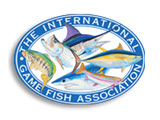African Pompano
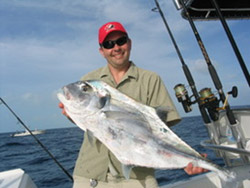 African Pompano – Alectis ciliaris
African Pompano – Alectis ciliaris
Florida Record 50lbs. 8oz.
A little about them:
The African pompano is a widely distributed species of tropical marine fish in the jack family. They are found in tropical waters worldwide, with adults often inhabiting coastlines, while juveniles are usually pelagic, floating with ocean currents. The species lives in depths less than 300ft., consuming a range of crustaceans and small fishes. African pompano are a highly rated game fish, often considered one of the strongest of the jacks in larger sizes.
Feeding patterns and unique characteristics:
African Pompano are found over the deep wrecks to the south of Key West. The juveniles have a distinctive ‘threadfin’ appearance of having trailing anal and dorsal fin filaments which recede with age. During maturation, the species also becomes more elongate and more like that of other jacks. The body is a silvery-metallic blue to blue-green color above, being darkest on the head and upper shoulders while the underside is more silvery
What you and your guide are looking for:
Fishing for African Pompano is basically like fishing for any other jack in the deep. They prefer live baits dropped to the depth you mark them on the sounder. They have great eyesight; sometimes lightening the leader a few pounds makes all the difference. Wrecks with a lot of vertical relief usually make for better African Pompano fishing as opposed to the lower profile wrecks.
Capt. Paul Tryon, Capt. Roc Mcguffey and myfwc.com were excellent sources for this material.
Almaco Jack
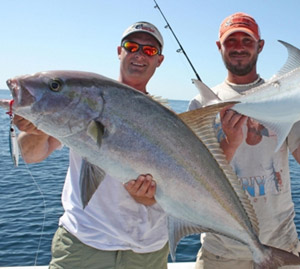 Almaco Jack – Seriola rivoliana
Almaco Jack – Seriola rivoliana
Florida Record n/a
A little about them:
The Almaco jack is a Key west favorite over the deep wrecks and reefs. They are super strong fighters and look very similar to the Amberjacks. Their flesh is thick and dense like tuna and can easily pass for white albacore.
Feeding patterns and unique characteristics:
The Almaco jack has a less elongated, more flattened body than most jack species. Their dorsal fin and anal fins are elongated with a definite sickle shape. The first rays of the Almaco dorsal fin’s longest parts are nearly twice as long as the dorsal spines different from other jacks. They reach a typical length of approximately 3 feet but can exceed 5 feet overall. Almaco jacks can tip the scales around 135 pounds.
Almaco jacks are generally dusky-colored with faint amber or olive stripes down their sides. Their upper bodies and lower fins are usually dark brown or dark blue-green. The belly is much lighter and appears brassy or lavender.
What you and your guide are looking for:
Almacos are mainly found on the deep wrecks on the Atlantic side . There are a few that actually hold more Almacos than their close cousins the AJ’s. Jigging and small live baits are the best ways to fish for them. Aside from being extremely strong fighters, their meat is excellent table fare.
Capt. Paul Tryon, Capt. Roc Mcguffey and myfwc.com were excellent sources for this material.
Amberjack
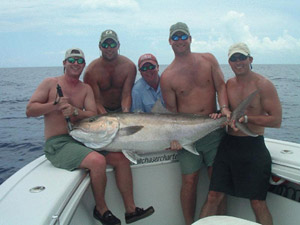 Amberjack – Seriola dumerili
Amberjack – Seriola dumerili
Florida Record 142lbs.
A little about them:
The name Amberjack refers to three species of Atlantic fish of the Carangidae family, which includes two jacks and Pompano. Greater Amberjacks are the largest of the jacks and are the species we are exploring here. Key West is home to behemoth Amberjacks, those fish that can exceed 100 pounds. We recently boated an 85 pounder onboard the TailChaser with Captain Paul Tryon at the helm. The monster Amberjack is proudly pictured on our home page at www.keywestproguides.com. Amberjacks are prized for their size, strength and tenacity when hooked. When battling large Amberjacks hooked while incorporating “deep drop” techniques these fish can take the measure of any angler. For pure “tug o’ war” fishing, Amberjacks top our list!
Feeding patterns and unique characteristics:
Great Amberjacks are easily recognized by their dark strips extending from the nose to just in front of their dorsal fins. Typically found around the reef, wrecks and isolated structures from 60′ to 240′ of water depths, juvenile Amberjacks can be caught as shallow as 25 feet of water. These Greater Amberjacks normally grow to about 40 pounds on average but can far exceed that weight.
Amberjacks are voracious predators, feeding on squid, fish and crustaceans and are thought to spawn offshore year round.
Lesser Amberjacks, which I will touch on briefly now, are colored with olive green to brownish black with silver sides. Often they will display a dark band-marking running upwards from their eyes, which are proportionately larger than Great Amberjacks. Lesser Amberjacks are typically less than 10 pounds and found much deeper than the Greater Amberjack. Lesser are commonly found from 300 to 750 feet deep.
What you and your guide are looking for:
Amberjacks prefer structure over Blue waters. The bigger ones like the deep wrecks, especially the 240 to 350ft. ones. They are easily hooked on big jigs or vertical jigs and will always take a large live bait. The smaller fish hang on the shallower wrecks in both the Atlantic and the Gulf.
Capt. Paul Tryon, Capt. Roc Mcguffey and myfwc.com were excellent sources for this material.
Barracuda
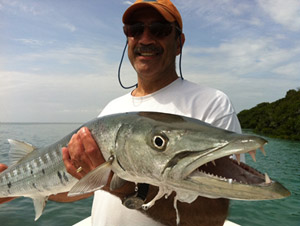 Great Barracuda – Sphyraena barracuda
Great Barracuda – Sphyraena barracuda
Florida Record 67lbs.
A little about them:
Can you imagine any fish that can grow in excess of one hundred pounds, reach lengths beyond six feet, swim at speeds up twenty seven miles per hour, ferociously attack fish larger than itself and can be found in warm salt water all over the world and yet be nearly completely overlooked by anglers. This is the Great Barracuda; I am going on record right here to say I think these are fantastic game fish that should be appreciated for what they are…super aggressive, apex predators.
Great Barracuda’s absolutely explode when striking. Renown for making sky-high leaps when hooked and you can expect several long, line stealing runs from every single Barracuda you catch. Barracuda’s are large and fearsome in appearance with unequalled tenacity and can be found in every tropical and subtropical ocean in the world.
Feeding patterns and unique characteristics:
Great Barracuda will eat anything in its habitat but prefer Needle Fish, Mullet and smaller Jacks around the island of Key West while feeding primarily on sight over smell. Barracuda will readily strike any number of flies, artificial swim baits and nearly all top water plugs when retrieved quickly. Attracted by shininess or flashes and fast movement the motion of skipping across the surface resembling the action of an injured but escaping bait fish will always promote a strike.
The Great Barracuda is a long, slender, torpedo shaped fish with a pointed large head and eyes. Barracuda’s have a large under-slung jaw with several protruding canine type pointed teeth. Bluish or greenish-grey body coloration above the lateral line with a silver-white belly along with irregular black blotches which are typically scattered but more so near the tail. Young Barracuda typically remain in shallow clear waters around Mangrove Islands etc. until they reach maturity before starting offshore to spawn. Smaller Barracuda often times will school but as the fish matures, they do become far more solitary especially when offshore. Curiosity is a common trait of all size and species of Barracuda. Typically, Barracuda move to the shallower waters during the summer months before returning to the offshore waters in fall and winter.
What you and your guide are looking for:
There are two basic ways that we target the Great Barracuda here in the Florida Keys, reefs & wrecks and the flats.
On the Reefs & Wrecks: Barracuda prefer structure to a wide open body of water. Almost all wrecks hold large schools of big Barracuda. They stay in the entire column of water, looking for any opportunity to feed. Spoons, plugs, tube lures and any small live bait presented at or near the surface is sure to get a strike. The faster you move your lure, the better and more often the strike. Schools of Barracuda in what is a seemingly structure free body of water is a sure sign of a wreck nearby as most are not on the charts.
On the Flats and in the Shallows: Fishing for them on the flats is an absolute blast. Barracuda are explosive strikers and in the shallows hit almost anything with flash and speed. Focus near the mouths of a channel, channel edges and drop-offs. They like to ambush their prey, anything that would hold baitfish is a great place to find the Great Barracuda.
Capt. Paul Tryon, Capt. Roc Mcguffey and myfwc.com were excellent sources for this material.
Blackfin Tuna
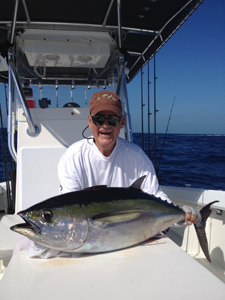 Blackfin Tuna – Thunnus atlanticus
Blackfin Tuna – Thunnus atlanticus
Florida Record 45lbs. 8oz.
A little about them:
The Blackfin Tuna is the smallest of the tuna species. They generally growing to a maximum of 39″ in length and max out around 46 lbs. Blackfin have oval shaped bodies, black backs with a slight yellow on the finlets, and have yellow on the sides of their body. Blackfin are only found in the western Atlantic from Cape Cod to Brazil.
Feeding patterns and unique characteristics:
Blackfin hunt both on the surface and down deep. They prefer fish and squid. They are a short-lived, fast-growing species; a 5 year old fish would be considered old. They reach sexual maturity at two years old, and spawn in the open sea during the summer. Blackfin tuna are a warmer-water fish, preferring water temperatures over 68°F. What they lack in size, they make up for in numbers and willingness to bite.
What you and your guide are looking for:
Blackfin Tuna here in Key West are caught both in the Gulf off the backs of Shrimp Boats, in the Atlantic on the deep wrecks and offshore under schools of Dolphin and baitfish. Looking for birds is a good way to locate a school feeding on baitfish. Chumming the deep wrecks with live baits is also very productive. When fishing for them off the shrimp boats, lots of chunk chum and ‘shrimp trash’ is a sure bet to fill the box.
Capt. Paul Tryon, Capt. Roc Mcguffey and myfwc.com were excellent sources for this material.
Black Grouper
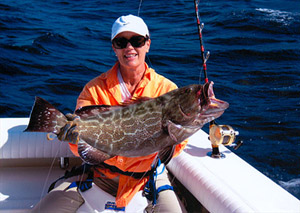 Black Grouper – Mycteroperca bonaci
Black Grouper – Mycteroperca bonaci
Florida Record 113lbs. 6oz.
Key West is renowned for its excellent reef & wreck or as some refers to it “bottom fishing”. The primary reason for this worldwide fame is the Grouper! Few fish have the strength and tenacity as the Grouper. Light tackle anglers have been playing “tug o’ war” with these brutes since rod and reel fishing made its way to the keys. Plentiful, strong, tasty…no matter why you target Grouper, the Key West reef & wrecks beckon you.
A little about them:
The black grouper is one of the best known of the large group of fish called Groupers. It lives mostly near the surface, at depths ranging from 20′ to 110 feet. The black grouper is quite tasty and an important food fish; it is fished for sale and for sport. It is very often mistaken for the similar Gag Grouper and the critically endangered Warsaw Grouper.
The Black Grouper is a large marine fish, growing up to 5′ in length and 220 in weight. It has an olive or gray body, with black blotches and brassy spots. The Black Grouper is typically a solitary fish. The fish spawns between May and August. It is a protogynous hermaphrodite, meaning the young are predominantly female, but transform into males as they grow larger. Adults are not found at the northern extremes of its range.
Feeding patterns and unique characteristics:
Adults feed mainly on other fish and squid, though the younger fish feed on crustaceans, especially shrimp. It is associated with rocky or coral reefs primarily, but is not dependent on them. Black Grouper are found in the western Atlantic Ocean, from about Massachusetts in the north to southern Brazil, but is particularly associated with the southern Gulf and the Florida Keys and Key West, the Bahamas and most of the Caribbean.
What you and your guide are looking for:
Black Grouper are found around any structure that they can hide and ambush prey from. Some of the most productive depths are from 30 to 140ft. Blacks. When you drift over these types of structure, dropping large, live baits to the bottom, then a few cranks up will usually bring an aggressive strike. They are extremely strong fighters, once hooked they try as hard as possible to get back to their structure. Most big blacks, say over 20lbs. will make it to the structure if your equipment is not of the heaviest. Sometimes, letting slack, making them not feel the pressure will get them to change holes, providing you the chance to ‘get back on them’.
Capt. Paul Tryon, Capt. Roc Mcguffey and myfwc.com were excellent sources for this material.
Blacktip Sharks
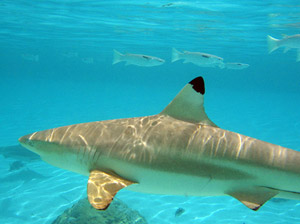 Blacktip Shark – Carcharhinus limbatus
Blacktip Shark – Carcharhinus limbatus
Florida Record 152lbs.
Key West offers the most exciting fishing most anglers will ever experience and surprisingly…it happens in the shallows! Shark fishing in Key West is awesome. Our warm waters bring these inspiring predators here in massive numbers, some are year round residents other migratory fish spending only a measured amount of time here. Either way, sharks are a plenty!
The Blacktip will quickly become a favorite for the first time shark angler. Beautiful, fast and elusive…that’s the Blacktip.
A little about them:
The Blacktip shark is a species of requiem shark, family Carcharhinidae. It is common to coastal tropical and subtropical waters around the world, including brackish habitats. Blacktip sharks are very common in the lower keys and especially Key West. These Blacktip should not be confused with the Blacktip Reef shark.
Feeding patterns and unique characteristics:
The Blacktip shark has a stout, body with a pointed snout, long gill slits, and no ridge between the dorsal fin. Most individuals have black tips or edges on the pectoral, dorsal, pelvic and caudal fin. It usually attains a length of about 5 feet.
Swift, energetic Blacktip sharks are known to make spinning leaps out of the water while attacking schools of small fish. Their demeanor has been described as somewhat “timid” compared to other large requiem sharks.
Normally wary of humans, Blacktip sharks can become aggressive in the presence of food and have been responsible for a number of attacks on people. There are reports of Blacktip sharks showing curiosity towards divers, but remaining at a safe distance. Under most circumstances, this timid shark is not regarded as highly dangerous to humans. However, their size and speed invite respect. As of 2008, 28 unprovoked attacks (one fatal) and 13 provoked attacks by this species had been reported. Blacktip sharks are responsible annually for 16% of the shark attacks around Florida. Most attacks by this species result in only minor wounds
Fish make up some 90% of the Blacktip shark’s diet. A wide variety of fish have been recorded as prey for this species.
What you and your guide are looking for:
Blacktip sharks are found both on the wrecks and reefs and in the shallows. Mullet muds are a great place to find them in the bay, they also prefer the deeper channels where lots of prey hold like Lady Fish, Mullet and Jacks. On the wrecks they school with the baitfish, targeting them on the surface usually pays off quite well.
Capt. Paul Tryon, Capt. Roc Mcguffey and myfwc.com were excellent sources for this material.
Bluefish
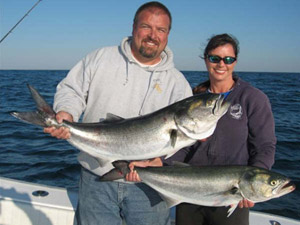 Bluefish – Pomatomus saltatrix
Bluefish – Pomatomus saltatrix
Florida Record 22lbs. 2oz.
Bluefish can provide the ultimate fast paced action for the light tackle angler. Bluefish strike hard and attack bait in a frenzy. Fly Casters love them for readily taking several fly patterns. A warning to anglers…Bluefish should be handled with caution due to their ability to snap at unwary hands. Fishermen have been severely bitten, and it helps to wear gloves. It is not a good idea to give Bluefish a little kiss before releasing as so many freshwater Bass anglers do!
A little about them:
Bluefish are typically winter time visitors to Key West although some years we find them in the Gulf all year long. Usually by April they have for the most part disappeared heading north.
The Bluefish is the only extant species of the Pomatomidae family. It is a marine pelagic found around the world in temperate and tropical waters on much of the continental shelves along eastern America (though not between south Florida and northern of South America). They are typically found in clear, energetic waters near surf beaches or by rock headlands. They also enter our backcountry estuary waters. Periodically, they leave our coasts and migrate in massive schools through open waters.
Feeding patterns and unique characteristics:
The bluefish is a moderately proportioned fish, with a broad, forked tail. The spiny first dorsal fin is normally folded back in a groove. Coloration is a grayish blue-green dorsally, fading to white on the lower sides and belly. Its single row of teeth in each jaw are uniform in size, knife-edged and sharp.
Bluefish commonly range in size from seven-inch to much larger, sometimes weighing as much as 40 pounds though fish heavier than 20 pounds are exceptional.
Adult bluefish reproduce during spring and summer, and can live for up to 9 years. As with most marine fish, their spawning habits are not well known.
What you and your guide are looking for:
Adult bluefish are strong and aggressive, and live in loose groups. They are fast swimmers which prey on schools of forage fish, and continue attacking them in feeding frenzies even after they appear to have eaten their fill. Depending on area and season, they favor menhaden and other sardine-like fish. In Key West jacks, grunts, shrimp and squid are all on the Bluefish menu. They are cannibalistic and can destroy their own young. Bluefish sometimes chase bait through the surf attacking schools in very shallow water, churning the water like a washing machine. This behavior is sometimes referred to as a “bluefish blitz”.
Capt. Paul Tryon, Capt. Roc Mcguffey and myfwc.com were excellent sources for this material.
Bonefish
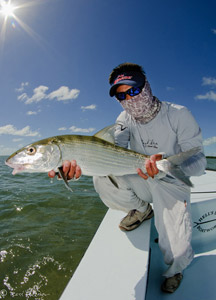 Bonefish – Albula vulpes
Bonefish – Albula vulpes
Florida Record 16lb. 3oz.
Bonefish and flats fishing are synonymous to Key West and the tropics. The thrill of witnessing “tailing” Bonefish within casting range is the stuff of legends. The thrill of hooking one of the fastest swimming fish in the shallows is addicting. Fly fishers & light tackle anglers travel from around the planet to visit and pursue our enormous Key West “Bones”. Warning…bonefishing can become an obsession!
A little about them:
Bonefish are considered to be one of the top three flats species to target. Their blistering runs of 50-75 yards will test any fisherman out there. They have tremendous eyesight and are easily spooked. Sneaking up clos to them to present a fly or jig with shrimp can be a daunting task. This fish blends in like no other, having a guide with exceptions eyes to spot them is imperative.
Feeding patterns and unique characteristics:
Bonefish can be found all over the warm waters of the Florida keys, Bonefish prefer the shallow grass patches when feeding on tasty treats like; crabs, shrimp, worms and mollusks. Bonefish prefer the shallows for a few different reasons. One reason is that the shallows offer protection from predators like Sharks and Barracudas. The Bonefish design is considered “perfect” The mirror-like scales of a bonefish help them blend in with their surroundings and make it difficult for predators, especially the Barracuda from seeing them. Bonefish also have extremely good eyesight, this not only makes it harder for predators to get close, it makes it exceedingly difficult for us to also.
What you and your guide are looking for:
There are two basic telltale things to look for when you and your guide are stalking Bonefish.
“Tailing” & “Mudding” – This would be considered the best situation to be in when you are stalking the “Grey Ghost”. Tailing Bonefish are very difficult to spot, unless you have the trained eye. A good guide knows the difference between light wind wisps and true tailing bones, both look similar. When Bonefish feed, they orientate themselves so that their snouts are buried somewhat in the bottom as they forage for a meal. When they are in this position, their translucent tails waver out of the water, just a little. This would be the ideal situation for the perfect cast; Bonefish that are feeding this aggressively are not easily spooked and will readily eat a fly or shrimp-tipped jig.
“Cruising” – Bonefish that are cruising are not really interested in feeding. When looking for bonefish that are cruising, look for “nervous water” Nervous water has a different ripple than the water surrounding it. These fish are on high alert for predators and WILL spook at the slightest disturbance. If you find yourself stalking a school on the move, lead them a good ways and let your fly or jig settle just above the grass a little, slight twitches when they are close should get a look-see.
When are they hungry?:
Bonefish are here year round and prefer water temps 72 degrees or warmer. The best months to fish for them are from Mid February through and middle of November. They to tend to seek deeper water in the winter months when the cold fronts move through, but are right back on the flats a few days later. Best months to fish for them are April, May, June, July, August, September & October.
Capt. Paul Tryon, Capt. Roc Mcguffey and myfwc.com were excellent sources for this material.
Bonita
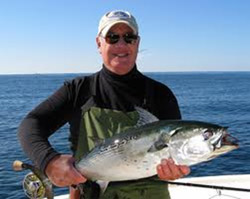 Atlantic Bonita – Sarda sarda
Atlantic Bonita – Sarda sarda
Florida Record 6lb. 8oz.
A little about them:
Bonita are amazing fish similar in attitude to Mackerel or Tuna. Stout, muscle bound little fish capable of super-sonic speeds in the water! Few fish are more fun to target than schooling Bonita as they slash and attack baits near the surface, a fly fishers dream come true! Bonita are strong swimmers normally traveling in fairly large schools and are common offshore. In Key West, Bonita are also known as “Little Tunny”
Feeding patterns and unique characteristics:
Bonita have a body completely scaled with those scales in the pectoral fin area usually larger in size. Bonita differ from Tuna by their compressed bodies, their lack of teeth on the roof of the mouth, and certain differences in coloration. The Atlantic bonita can be distinguished from its relatives by its dark oblique stripes on the back and with a maxillary only about half as long as the head. Atlantic bonita grow up to 30 inches and weigh 10 to 12 pounds typically. The world record is 18 pounds and 4 ounces, and was caught in the Azores.
What you and your guide are looking for:
Bonitas are found in the open ocean and on the deep wrecks and reefs. They usually have huge flocks of birds working over them when they are feeding heavily on baitfish. They will readily hit just about anything thrown their direction; spoons, top water lures, and any live bait. While terrible as food, they make great chunked bait for Wahoo, small cut bait for Snappers and Groupers and sharks find them quite tasty.
Capt. Paul Tryon, Capt. Roc Mcguffey and myfwc.com were excellent sources for this material.
Bull Shark
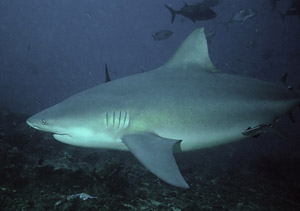 Bull Shark – Carcharhinus leucas
Bull Shark – Carcharhinus leucas
Florida Record 517lbs.
The Bull shark, is commonly found worldwide in warm, shallow waters along coasts and in rivers. The name bull shark comes from the shark’s stocky shape, broad, flat snout, and aggressive, unpredictable behavior. Bull sharks are grey on top and white below. The second dorsal fin is smaller than the first. The Bull shark is known for its aggressive nature, predilection for warm shallow water, and presence in brackish and freshwater systems including estuaries and rivers.
A little about them:
The bull shark surprisingly can thrive in both saltwater and freshwater and can travel far up river waterways. The bull shark is commonly found worldwide in coastal areas of warm oceans, in rivers and lakes and occasionally even salt and freshwater streams if they are deep enough. Bull sharks have been reported in depths of 500 ft, but do not usually swim deeper than approximately 100 ft… After Hurricane Katrina, many Bull sharks were sighted in Lake Pontchartrain. Bull sharks have occasionally been sighted in the Mississippi River as far upstream as Illinois. Bull sharks have also been found in the Potomac River in Maryland. Bull sharks have even been known to travel as far as Kentucky via the Ohio River. Thankfully, there have been few recorded attacks in these waters by Bull Sharks. However, they are probably responsible for the majority of near-shore shark attacks, including many attacks attributed to other species of sharks
Feeding patterns and unique characteristics:
Bull sharks are large and stout, with females being larger than males. Adult female bull sharks average 8 to 10′ long and typically weigh 300 lbs, whereas the slightly smaller adult male averages 8′ and 210 lb. While a size of 11 ft is commonly reported, there are records of specimens as large as 13 ft and of weights as high as 1,270 lb. Bull sharks are wider and heavier than other requiem sharks of comparable length. Bull sharks have a bite force of up to 1,300 lb, the highest among all investigated cartilaginous fishes.
A bull shark’s diet consists mainly of fish and smaller sharks, including other bull sharks, but can also include turtles, birds, dolphins, terrestrial mammals and stingrays. They hunt in murky waters because it is harder for the prey to see the shark coming. Bull sharks have been known to use the bump then bite technique to attack their prey.
Bull sharks are typically solitary hunters, but occasionally hunt in pairs. They often cruise through shallow waters. They can accelerate rapidly and can be highly aggressive. Bull sharks are extremely territorial and attack animals that enter their territory. Since bull sharks often dwell in very shallow waters, they may be more dangerous to humans than any other species of shark, and along with the Tiger shark, Oceanic White Tip and Great White are among the four shark species most likely to attack humans.
Bull sharks mate during late summer and early autumn, often in the brackish water of river mouths. After gestating for 12 months, a bull shark may give birth to four to ten live young. They are viviparous meaning they are born live and free-swimming. The young are about 28 inches at birth and take 10 years to reach maturity. Coastal lagoons, river mouths, and other low-salinity estuaries are common nursery habitats.
Bull sharks are apex predators and rarely have to fear being attacked by other animals. Humans are their biggest threat. Larger sharks, such as the Tiger and Great White may attack Bull sharks.
What you and your guide are looking for:
Bull sharks are found everywhere. When we target them we generally look to the deeper Atlantic wrecks, more than 120ft. and the Gulf wrecks. In the Gulf they hold on the old WWII era wrecks by the Dozens. They are monster fish out there, some reaching 10-12ft. they hold large schools of Cobia, all looking to pick off the scraps from their last meal. Any large baitfish is sure to hook one up. In the shallows they travel alone and prefer the deeper channels. Large fresh Bonita or Barracuda are best baits. Fish near a deep channel, but on the flat side to spot them.
Capt. Paul Tryon, Capt. Roc Mcguffey and myfwc.com were excellent sources for this material.
Cero Mackerel
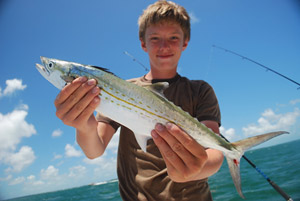 Cero Mackerel – Scomberomorus regalis
Cero Mackerel – Scomberomorus regalis
Florida Record 17lbs. 2oz.
A little about them:
Cero Mackerel like the entire Mackerel family are super aggressive and typically schooling fish. Cero attach baits with a true “killer instinct” that makes for fast and solid strikes all light tackle anglers will appreciate. King and Spanish mackerel often overshadow Cero but believe me friends when I tell you…Cero can hold their own!
Feeding patterns and unique characteristics:
Cero are also known as the cero mackerel or painted mackerel. Ceros’ are similar in appearance and coloration to the Atlantic Spanish mackerel except the Cero has a longitudinal stripe in addition to the spots of the Spanish. The first dorsal fin is black interiorly; the lateral line descends slowly from the shoulder without the sharp break seen on the king mackerel. The Cero reaches larger sizes than the Spanish, often 10 pounds or more, but those over 30 pounds are extremely rare. In Florida, it is rare north of Palm Beach but very common throughout the Florida Keys and throughout the West Indies.
What you and your guide are looking for:
Cero mackerel are voracious, opportunistic carnivores. As with other members of the Mackerel family, food consists mainly of small fishes with lesser quantities of shrimp and squid. Cero mackerel are found on the patch reefs in both the Atlantic and Gulf. Looking for large flocks of birds is a sure sign of mackerel activity nearby. You also find schools of Cero mackerel in the lower Keys basins and channels. They prefer top water plugs and flashy spoons. Fast erratic movement works best as they are reactive strikers.
Capt. Paul Tryon, Capt. Roc Mcguffey and myfwc.com were excellent sources for this material.
Cobia
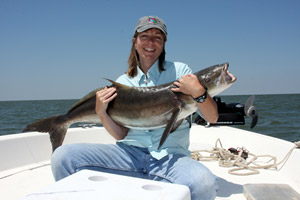 Cobia – Rachycentron canadum
Cobia – Rachycentron canadum
Florida Record 130lbs.
Few things can bring the adrenalin rush than that of a behemoth Cobia on the surface. Massive fish with no fear willing to battle you right at boat side! Cobia are super aggressive feeders with a crazy curiosity. Cobia strike with a vengeance rarely seen in saltwater! Capable of besting the most avid angler and high tech gear, Cobia are “old school” fighters…strongest wins!
A little about them:
Cobias are found in warm temperate to tropical waters from the east Atlantic throughout the Caribbean and as far away as the Indo-Pacific of India, Australia and Japan. Cobia are pelagic fish which remain nearly solitary until spawning, but do congregate in Key West on our reefs, ship wrecks, in our harbor and are often seen relating to channel buoys and other structures. Cobia will also enter our shallow back country estuaries and mangroves in search of prey illustrating how well Cobia tolerate wide ranges of water temperatures.
Feeding patterns and unique characteristics:
Cobias are crab eaters first, but will also forage on Squid and other baitfish. Cobias are well known to shadow larger sharks, rays and even turtles to scavenge food. A Cobia downfall is they are extremely curious fish and seem to pay no attention to a boat often times following hooked fish in and then lingers to see the action. Cobias grow to much large proportions than most anglers might think. They have been known to exceed 80 inches in length and tip the scales at 150 pounds. Until recently, the largest Cobia caught by rod and reel was 135 pounds but that record no longer stands. Cobias have broad, flattened heads on an elongated body with small eyes and a lower protruding jaw line. On the tongue, jaws and roof of the mouth there are rows of fibrous teeth.
Cobias being pelagic spawners release their eggs as they swim. These buoyant eggs flow freely on the currents until hatching. Cobia live long lives to fifteen years. The males mature about two years old with the females needing another year before spawning. From April through September in Key West, Cobia will spawn offshore. The females may spawn up to thirty times during this period in one to two week intervals. Cobias make long migrations wintering in the Gulf of Mexico.
Cobias are super aggressive strikers that provide exceptional power and tenacity when hooked. Sight casting to surface cruising groups of two to five fish is common over the reef and wrecks in Key West. These behemoth pelagic fish are always welcome as table fare to those in the know.
What you and your guide are looking for:
Cobias often times travel in schools and can be found at the surface providing exceptional sight casting opportunities for the angler. A common Key West technique is to bring a well hooked and played-out Cobia boat side but let it remain in the water. The lingering school will likely come very close out of curiosity allowing anglers to repeatedly hook the residual fish from the school.
Cobias are interesting fish in appearance and often are mistaken for sharks. Smooth bodies with very small scales colored from dark brown backs to white underbellies. Typically, during spawning two darker brown horizontal stripes appear on their flanks. Their large pectoral fins are at times held horizontally which may cause the most mistaken identifications as sharks.
Capt. Paul Tryon, Capt. Roc Mcguffey and myfwc.com were excellent sources for this material.
Dolphin
 Dolphin or ‘Dorado’ – Coryphaena hippurus
Dolphin or ‘Dorado’ – Coryphaena hippurus
Florida Record 81lbs.
When the summer months arrive in Key West the anglers head offshore to the weed lines near the reef in search of frigate birds or floating debris for these are the favored locators of our bread & butter fish…Mahi-Mahi the common dolphin fish. Prized by anglers for beauty, size and as table fare our Mahi-Mahi fishing is some of the best anywhere. These acrobatic fish renowned for ariel displays as breathtaking as the “Flying Wallendas” Mahi-Mahi are the perfect target for the experienced angler armed with light tackle to the family outing looking for excitement. Beautiful fish that mate for life, the adult males known as Bull Dolphin are impressive swimmers and veracious feeders. Easily found and hooked up…Mahi-Mahi are everyone’s favorite summertime fish!
A little about them:
Also known widely as Dorado or mahi-mahi among several other names but all refer to a surface dwelling, ray-finned fish found in temperate and tropical offshore waters world wide. Just to set the record straight here…this information is referring to the common dolphin fish. Although there are two dolphin fish species that exist, the common dolphin fish and the pompano dolphin fish it is not unusual for people to confuse these fish in conversation with the more widely known marine mammals called dolphins. These two vastly different species have nothing much in common.
As so many times is the case, the Hawaiian name for tropical waters fish when translated tell the story. Mahi-Mahi means “very strong”. Mahi-Mahi are short lived fish just 4 to 5 years on average. Adult Mahi-Mahi in our local Key West waters will range from about 15 pounds to the high 20’s but those specimens that exceed 30 pounds are rare. 40 pound plus Mahi-Mahi are exceptional.
Feeding patterns and unique characteristics:
Mahi-Mahi have compressed bodies with a dorsal fin that extends nearly its full length. The Caudal and anal fins are concave. The Mahi-Mahi in my opinion is the most beautiful of our sport fish with their dazzling colorations. The backs and sides are bright blues and greens with golden hues tossed in for good measure. Our Key West Mahi-Mahi when out of the water display yet more colors and hues giving rise to their Spanish names dorado maverickos or “golden mavericks” Even in the throws of death the Mahi-Mahi fades to a yellow-grey.
The larger of the sexes are males (Bulls) easily identified by their large prominent foreheads while females (Cows) have a more rounded head shape. Extremely fast growing fish they spawn throughout the year in our warm currents and waters. Their young are easily found in sea weed.
Mahi-Mahi are carnivorous feeding on flying fish, crabs, squid and mackerel as forage. I have read that it is believed Mahi-Mahi also eat zooplankton and crustaceans.
Not surprisingly, Mahi-Mahi are sexually mature by 4 to 5 months and females can spawn two or three times per year developing between 80,000 and 1 M eggs per cycle.
What you and your guide are looking for:
Offshore guides prefer to locate a floating weed line of Sargasso. These weed lines can be whole ecosystems containing microscopic creatures to seahorses to baitfish. Our guides always “look to the frigate birds” as diving birds indicate the presence of bait, which in turn holds fish. These pro’s can tell you what species of fish are present from long distance by the actions of the birds while diving.
Light tackle spinning gear is the Key West Pro Guides first choice as they fell the typical 30 to 50 pound class equipment used by many sport fishing boats is simply to heavy to enjoy the fight. Fly casters absolutely will appreciate the eagerness with which Mahi-Mahi attack flies. From hook less teasers to whole Ballyhoos trolled will take Mahi-Mahi. By tossing a net full of live baits into the water the Key West Pro Guides create feeding frenzies which keep the schooling fish at the boat allowing every rod on the boat to sample the acrobatics.
Capt. Paul Tryon, Capt. Roc Mcguffey and myfwc.com were excellent sources for this material.
Gag Grouper
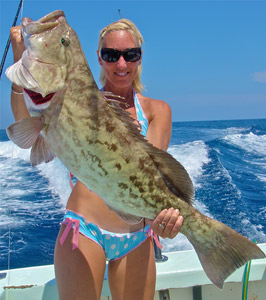 Gag Grouper – Mycteroperca microlepis
Gag Grouper – Mycteroperca microlepis
Florida Record 80lbs. 6oz.
Gag Grouper is something of the “blue collar” Grouper. Nothing to fancy, not so flashy but solid and dependable for a good fight. Dropping live baits down to waiting Gag’s is always a memorable fishing experience. Fast to strike and strong willed, Gag’s simply put…have no quit in ’em” Rarely does the angler have the opportunity to consistently hook 10 to 20 pound fish all day long. Target the Gag Grouper with a reef & wreck pro at Key West Pro Guides and you’ll find out exactly what I’m talking about friend.
A little about them:
The gag grouper (Mycteroperca microlepis) is a drab, mottled-gray fish lacking the distinguishing features of other groupers. Its pattern of markings resemble the box-shaped spots of the Black Grouper. 10 to 20 pound fish are common in Key West. The world record is 80 lb 6 oz.
Feeding patterns and unique characteristics:
The Gag grouper is a bottom feeder and is often caught by fishermen seeking bottom-dwelling species, such as Snappers. Its flaky white meat is considered quite delicious as table fare.
What you and your guide are looking for:
Gag grouper are found in areas of hard or consolidated substrate, and use structural features, such as ledges, rocks, and coral reefs (as well as artificial reefs, such as wrecks and sunken barges) as their habitats. They readily take live bait, jigs and slow trolled lures that dive deep.
Capt. Paul Tryon, Capt. Roc Mcguffey and myfwc.com were excellent sources for this material.
Goliath Grouper
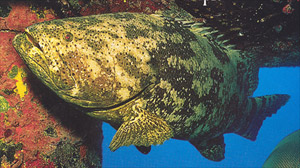 Goliath Grouper – Epinephelus itajara
Goliath Grouper – Epinephelus itajara
Florida Record 680lbs.
The Goliath Grouper sits at the head of the table in Key West. No fish comes close in size or reputation to the Goliath. These Jurassic sized behemoths rule the reef and ship wrecks around Key West with an iron fist! No one can explain the sheer brute strength of a 300 pound plus bottom dweller…you have to experience it for yourself. Now you can with the pro’s at Key West Pro Guides. The Goliath Grouper is a fish of a lifetime and they are waiting for you in the depths of our Key West waters.
A little about them:
The Atlantic Goliath Grouper, commonly known as the jewfish, is a large saltwater fish of the grouper family found primarily in shallow tropical waters among coral and artificial reefs at depths from 15 to 165 ft. Its range includes the Florida Keys, Bahamas and most of the Caribbean. Young Atlantic goliath grouper may live in estuaries, canals, and mangrove swamps, unusual behavior among groupers. Juvenile Goliath Grouper are commonly hooked while fishing near the mangrove islands of the Key West backcountry.
Feeding patterns and unique characteristics:
Goliath grouper eat crustaceans, other fish, octopuses and young sea turtles Grouper are preyed upon by large fish, such as Barracuda, Moray Eels and large sharks.
They may reach extremely large sizes, growing to lengths of 8.5 feet and can weigh as much as 800 pounds. The world record for a hook and line-captured specimen is 680 pounds, caught off Fernandina Beach, Florida, in 1961. They are usually around 400 pounds when mature.
Until a harvest ban was placed on the species, its population was in rapid decline. The fish is entirely protected from harvest and is recognized as a critically endangered species by the World Conservation Union. The US began protection in 1990 and the Caribbean in 1993. The species’ population has been recovering since the ban; with the fish’s slow growth rate, however, it will take some time for populations to return to their previous levels.
What you and your guide are looking for:
The Goliath can be found on almost any type of wreck or structure with a decent amount of relief or height. They frequent nearly all of the Gulf wrecks and as juveniles can easily be found along mangrove ledges and drop offs. Any large bait presented is sure to get hit, only the biggest and heaviest tackle will give you a chance. Remember they are totally protected form harvest, you must release them.
Capt. Paul Tryon, Capt. Roc Mcguffey and myfwc.com were excellent sources for this material.
Hammerhead Shark
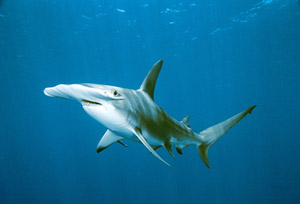 Hammerhead Shark – Sphyrna spp
Hammerhead Shark – Sphyrna spp
Florida Record 1060lbs.
The awe-inspiring Hammerhead Shark brings a whole new dimension to light tackle angling in Key West. This apex predator swims alone through the dark waters after sunset searching for unsuspecting forage. A immense silhouette stealthily searching the ocean floor before violently attacking. Imagine the silent darkness all about you as tensions rise on the take of a Hammerhead Shark…this goes beyond fishing friends…the Hammerhead is capable of taking you to the next level.
A little about them:
Hammerhead sharks are a group of sharks in the family Sphyrnidae, so named for the unusual and distinctive structure of their heads, which are flattened and laterally extended into a “hammer” shape called a “cephalofoil”.
Feeding patterns and unique characteristics:
Hammerheads are found worldwide in warmer waters along coastlines and conventional shelves. Key West have several Hammerheads especially during the Tarpon spawning migration which takes place yearly from March through August. The Hammerhead feeds on large Tarpon so simply follow the schools of into the shallows and Key West Harbor. Unlike most sharks, hammerheads usually swim in schools during the day, becoming solitary hunters at night typically about sunset.
The nine known species of Hammerheads range from 3 to 20ft. long and weigh from 7 to 1,300 lb. Hammerhead range up to 14 feet in Key West regularly. Although several hammerhead species are quite large, these are more slender and streamlined compared to other large sharks, which undoubtedly increase their speed and maneuverability in the water.
Hammerheads are usually light gray and have a greenish tint to them. Their bellies are white which allows them to be close to the bottom of the ocean and blend in to sneak up on their prey. Their heads have lateral projections, which give them a hammer-like shape.
What you and your guide are looking for:
In shallow water their large dorsal fin is unmistakable. You’ll know when there is one around; your guide will act like a 5 year old at his first trip to Disney!! Hammerhead sharks are known to eat a large range of items including fish, squid, octopus, crustaceans, and other hammerhead sharks. Stingrays are a particular favorite. These sharks are found many times swimming along the bottom of the ocean, stalking their prey. Their unique head is used as a weapon when hunting down prey. The hammerhead shark uses its head to pin down stingrays and eats the ray when the ray is weak and in shock. There is a species of the hammerhead shark that is more aggressive and large in size, the Great Hammerhead. These sharks tend to be super aggressive and as an apex predator eat squid, octopus, and other hammerhead sharks. They are also known to eat their own young.
Capt. Paul Tryon, Capt. Roc Mcguffey and myfwc.com were excellent sources for this material.
Hogfish
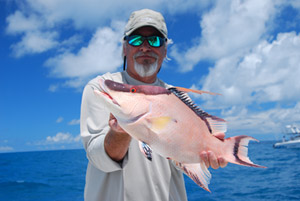 HogFish – Lachnolaimus maximus
HogFish – Lachnolaimus maximus
Florida Record 19lb. 8oz.
The Hogfish is a recreational important species. It is a commonly targeted species for many spear and reef fisherman as it is highly regarded for its taste and food value. Not often taken on rod & reel, catching a Hogfish is like getting the largest gift box at Christmas!
A little about them:
The Hogfish is a member of the wrasse, Labridae, family. The hogfish is one of the larger species of wrasses and is found in the western Atlantic Ocean with a range from Bermuda, south through the Caribbean Sea and northern Gulf of Mexico, continuing to the north coast of South America. Hogfish are very abundant in the Florida Keys.
Feeding patterns and unique characteristics:
The hogfish is characterized by a large laterally compressed body shape. It possesses a very elongated snout which it uses to search for crustaceans buried in the sediment. Interestingly it is from this very long “pig-like” snout and its rooting behavior that the hogfish gets its name.
The hogfish is a sequential hermaphrodite. Which means it changes sex during different life stages. The hogfish is a protogynous, “first female” hermaphrodite. The change usually occurs around 3 years of age and about 14 inches in length. A prominent black spot behind the pectoral fins easily differentiates male from female Hogfish. Females and juveniles begin life as a pale gray or reddish brown with a paler underside and no distinct color patterns. Males are signified by their coloration and have a deep dark band spanning from their snout to the first dorsal spine.
Hogfish reach a maximum size of about 3 feet and approximately 22 pounds and have been recorded to live up to 11 years. Spawning in South Florida occurs from November through June. Interestingly, Hogfish social groups are organized into “harems” where one male will mate and protect a group of females in its territory.
Capt. Paul Tryon, Capt. Roc Mcguffey and myfwc.com were excellent sources for this material.
Jack Crevalle
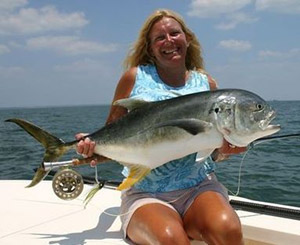 Jack Crevalle – Caranx hippos
Jack Crevalle – Caranx hippos
Florida Record 57lbs.
A Jack Crevalle’s brute power is well established and will impress any light tackle angler. Big Jacks are marauders of their habituate simply taking over when they choose. Like gang-land thugs, Jacks are street fighters willing to get down in the gutter and battle it out face to face. For the sheer thrill of the strike…cast a top water plug into the middle of a school of feeding Jacks…better hang on tightly to your favorite fishing rod friend…a big Jack can tear it from your hands!
And the pro’s at Key West Pro Guides know just where to find them in Key West!
A little about them:
The Crevalle Jack, (also known as the common jack or black-tailed trevally,) is a common species of large fish classified within the large Jack family, The Crevalle Jack is found across the tropical and temperate waters of the Atlantic Ocean.
Feeding patterns and unique characteristics:
The Jack Crevalle found in Key West is distinguishable from similar species by its deep body, fin coloration and a host of more detailed anatomical features, including lateral lines. Jack Crevalle are large fish growing to a maximum known weight of 70 pounds, although is rare at lengths greater than 35 inches. The crevalle jack lives in both inshore and offshore habitats, with larger adults preferring deeper waters than juveniles do. In the inshore environment, Crevalle Jack inhabit shallow flats, sandy bays, beaches, sea grass beds, shallow reefs and Lagoons. Young fish dispersed north by currents in the eastern Atlantic are known to migrate back to more tropical waters before the onset of winter; however, if the fish fail to migrate, mass mortalities occur as the temperature falls below the species’ tolerance limits.
What you and your guide are looking for:
The Crevalle Jack is a powerful, predatory fish, with extensive studies showing the species consumes a variety of small fish and invertebrates such as shrimp and crabs. In the shallows, they like to hang with large sharks, picking off the scraps form their last meal. In the deeper channels they school, looking for baitfish. On the wrecks and reefs, they tend to be much larger, chasing large schools of bait above the structure.
Capt. Paul Tryon, Capt. Roc Mcguffey and myfwc.com were excellent sources for this material.
King Mackerel
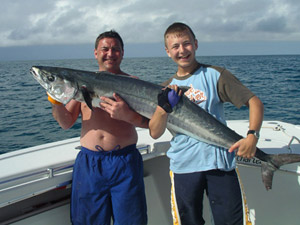 Kingfish – Scomberomorus cavalla
Kingfish – Scomberomorus cavalla
Florida Record 90lb.
A little about them:
The King Mackerel is a pelagic or migratory species of mackerel that calls the western Atlantic and Gulf of Mexico home. Kings are commonly found from the Carolinas to Brazil and as far south as Rio de Janeiro. They are found in the Gulf as well but prefer water temperatures between 68 and 85 degrees F. In our local Key West waters, typically Kings are found in the 40′ to 150′ depth range. However, it is not uncommon to find larger specimens those of twenty pounds or more, near the Gulf Stream or at the mouth of inlets and harbors.
Feeding patterns and unique characteristics:
Here in Key West the average King Mackerel ranges from five to thirty pounds but have been caught to ninety pounds. Their body is covered with small scales with a spiny but colorless dorsal fin. Coloration is olive like on their backs fading to silver beneath with a “rosy” iridescence, which fades to a white underbelly. Interestingly the lateral line starts high on the shoulder dipping sharply at mid body then continues in a wavy like pattern to the tail. King Mackerel are well armed with large edged teeth set closely and flattened on each side. Often smaller Kings are mistakenly identified as their smaller cousins Spanish and Cero Mackerel. The easiest way of properly identifying the King Mackerel is by the missing black “patch” on the spiny dorsal fin region which both of the other mackerel display.
At least two migratory groups of Kings have been well documented and tracked via tagging programs which confirm the Kingfish found in Key West between October and March have migrated from the Texas coast, their summer home and spawning grounds. A second group migrates from North Carolina becoming plentiful to east and south central Florida. Spawning occurs there in May through August before the Kings slowly return north. Females mature at about seven years weighing on average about 21 pounds. Depending on size, the female may shed from 50,000 to several million eggs during the spawning season. Male Kings by seven years will average closer to 11 pounds and typically never exceed 15 pounds. Therefore, the larger Kings (over 20 pounds) are most likely females.
What you and your guide are looking for:
King Mackerel are voracious and carnivores feeders readily preying on numerous fish but with a preference for Cigar minnows, threadfin, jacks blue runners and grunts or especially sardine like fish such as menhaden or striped anchovies. They are found in large schools when spawning in both the Atlantic and the Gulf. Looking for huge flocks of birds can help locate these schools; they also prefer structure that holds baitfish. Jigging is a very effective way to target them, as is sending back live ballyhoo with a trace of steel leader.
Capt. Paul Tryon, Capt. Roc Mcguffey and myfwc.com were excellent sources for this material.
Lady Fish
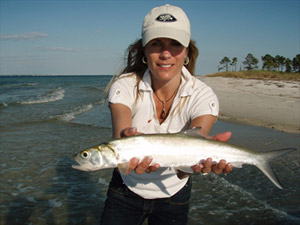 Lady Fish – Elops saurus
Lady Fish – Elops saurus
Florida Record 6lbs. 4 oz.
The Lady Fish will always bring a smile to the face of the lucky angler hooked up with one. Lady Fish have an amazing tenacity and although not of brutish proportions can still “bring it” nevertheless. Impossible for the light tackle or fly caster to pass up, schools of Lady Fish can provide fast paced action with immediate strikes cast after cast. Lady Fish are dreams come true to novice anglers interested and happy to just “catch fish”. Never overlook the Lady Fish taking you back to a time when as a kid fishing was just plain exciting and fun!
A little about them:
The name comes from the Greek ellops – a kind of serpent. Lady Fish are abundant in the Key West backcountry and are referred to locally as “the poor man’s Tarpon” due to their explosive nature by leaping from the water when hooked. Typically, throughout the species the maximum size is approximately 3 ft and the maximum weight 6lbs. Lady Fish are coastal dwelling fish found throughout the tropical regions. Spawning takes place at sea and the fish larvae then migrate inland entering brackish waters.
Feeding patterns and unique characteristics:
The body is a tapering spindle shape being slightly laterally compressed silver in color. Interestingly the eyes are large and partially covered with eyelids. Lady Fish feed on primarily smaller fish and crust anions such as shrimp. Guides and anglers alike enjoy the acrobatic fish on light tackle spinning gear using any number of artificial plastic swim baits or jigs tipped with a live shrimp. A perfect choice for younger or more novice anglers Lady Fish can keep the rods bent all day long. Traveling in typically very large schools Lady Fish can easily be found in open shallow bays or in the Mangroves.
What you and your guide are looking for:
Mullet muds are a sure bet when looking for the Lady Fish. When the Mullet are mudding, they scare all kinds of smaller fish and crustaceans from their path; Shrimp, Crabs, small Pinfish and many other prey. Lady Fish prefer tall bay and turtle grass and deep holes within a basin. They hit both top water plugs with a fast action and most cut and small live baits when fished with a jig on the bottom. This family is fished for fun only as the body is bony and therefore not edible by humans
Capt. Paul Tryon, Capt. Roc Mcguffey and myfwc.com were excellent sources for this material.
Lemon Shark
 Lemon Shark – Negaprion brevirostris
Lemon Shark – Negaprion brevirostris
Florida Record 397lbs.
A little about them:
They are known as Lemon sharks because light interacting with seawater gives them a tanned and yellow, pitted appearance much like the surface of a lemon. This powerful and stocky shark with its pale yellow-brown to grey skin, which lacks any identifying markings, is perfectly camouflaged when swimming over the sandy bottom of its coastal habitat. It has a flattened head with a short broad snout and is easily recognized by its second dorsal fin being nearly as large as its first dorsal fin. Lemon sharks are viviparous meaning they give birth to live young typically numbering between four and seventeen every other year. Birthing takes place in warm, shallow lagoons where the young must immediately fend for themselves. The newborn sharks tend to remain near the Mangroves until reaching maturity allowing for venturing away from the lagoons and eventually to offshore waters where little is known about their next stage of life. Lemon sharks have become a favorite of scientists to study as they survive well in captivity. More is known about the Lemon shark than any other species of shark for this reason.
Feeding patterns and unique characteristics:
Lemon sharks feed both on the bottom and in the middle of the water column. They feed on both live and dead fish, crustaceans and sometimes marine birds. Lemon sharks prefer to feed on a moving tide, fresh Bonita or Barracuda is a favorite bait. Lemon sharks have very poor eyesight to find food but as are all sharks come equipped with electroreceptor concentrated in their heads. These receptors are used to detect electrical impulses omitted by potential prey. The most sensitive electroreceptors are found in the nose of the Lemon shark. Splashing the carcass of a Bonita or Barracuda in the water send distress signals that quickly draw them in.
What you and your guide are looking for:
There are two basic areas that we target Lemon sharks here in the Florida Keys, the deep reef and the flats.
On the Deep Reef:
Chumming for Yellowtail snappers has become a sure bet in attraction big, 8-10ft. lemon sharks. They dwell on the reefs where the large concentrations of Yellowtail call home. When you send out large amount of chum, you attract the Yellowtails. After hooking a few of them, the distress signals they send while being reeled in attract the sharks, not so much the chum, if at all. After a few fish on the line, you’ll sometimes see their light lemon shapes darting quickly after your fish. Remember their eyesight is poor at best, they dial in on the vibrations coming off the fish your fighting and 9 out of 10 times, get it. Sending back a fresh live Yellowtail with steel leader back behind the boat is a sure way to hook one up rather quickly. They also prefer smaller Bonita, Tuna, any fish that gives off vibrations while hooked.
On the Flats:
Fishing for them on the flats is an absolute blast. We look for water that is moving, an extremely important condition to have as moving water usually brings food to most fish. The idea here is to draw the sharks to the boat with lots of scent, not necessarily chum. Barracuda, Bonita, any large strong smelling bait. Within minutes they pick up on this scent and instinctively swim up current to find the source. This is where you can sight cast to them, sometimes finding more than 20 sharks around the boat within casting distance.
When are they hungry?:
Lemon sharks are always hungry, their sharks!! They tend to feed better on the darker moon phases than on a full moon during the day. They tend to prefer water temps between 68°-86° F to be very active. It is a very rare occasion to find Lemon sharks and them not feed, after all their sharks!!
Capt. Paul Tryon, Capt. Roc Mcguffey and myfwc.com were excellent sources for this material.
Mangrove Snapper
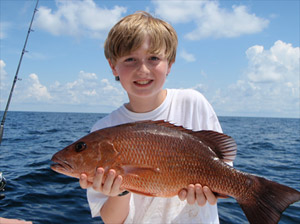 Mangrove Snapper – Lutjanus griseus
Mangrove Snapper – Lutjanus griseus
Florida Record 17lbs.
Mangrove Snapper are the foot soldiers of the Florida Keys and Key West. Always found in masses and ready to do battle. Armed with impressive K-9 teeth Mangrove Snapper are aggressive feeders. When targeted in the shallows Mangrove provide super-fast action…at times you cannot get a bait in the water quick enough. On the reef and deeper ship wreck sites you will experience a bit different attitude. One of power and tenacity. Mangrove Snapper are always ready and able!
A little about them:
The mangrove snapper, also known as the gray snapper or mango snapper. Its color is typically grayish red, but it can change color from bright red to copper red. It has a dark stripe running through its eye if observed from the top when it is underwater. Its size ranges from 2-6 pounds but many biologists have now confirmed a 29.5-lb Mangrove Snapper was speared off the coast of Louisiana.
Feeding patterns and unique characteristics:
The Mangrove Snapper is one of the most common species of Snapper in warmer regions. It can be found in many areas from canals to grass flats, as well as in open water. Most Mangrove Snapper in the open water are generally found near bottom structure or reefs. Mangrove snapper is a common target for anglers, and is highly prized for its light and flaky meat.
What you and your guide are looking for:
It can be caught on a variety of baits, but is typically caught with live or frozen shrimp, squid, minnows and occasionally on artificial lures or baits. Mangrove snapper are typically wary fish, and their wariness of baits tends to increase as the fish grow larger. Most mangrove snapper are caught on light to medium tackle, and typical catches range from eight to 14 inches in shallow or in-shore waters, to up to 20″ in deeper waters. Larger fish are uncommon, but not rare. Chum is sometimes used by anglers to attract Mangrove Snapper.
Capt. Paul Tryon, Capt. Roc Mcguffey and myfwc.com were excellent sources for this material.
Margate Snapper
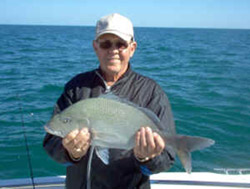 Margate – Haemulon album
Margate – Haemulon album
Florida Record 19lbs. 8oz.
The White Margate is also simply known as the Margate. It’s distinguished from the closely related Black Margate by its high back profile, light color, and small eye with a white iris. Its body is generally pale gray to silvery and its’ fins are usually gray.
A little about them:
The White Margate is a member of the Grunt family and closely related to snappers. White Margate are found throughout a range from Florida, the Bahamas, and the Caribbean.
Feeding patterns and unique characteristics:
White Margate are generally 10 to 20 inches in length. They can reach nearly 2 1/2 feet in length. They inhabit sand flats between patch reefs and are found over sea grass beds. They generally drift over these areas in small groups or as single fish. White Margate feed on bottom dwelling worms and urchins. They will often be seen slowly drifting over the sand flats in a nose down position as they search for their favorite foods. That’s the White Margate.
What you and your guide are looking for:
Margates can be caught in the deep and on the patches. When fishing the deep wrecks and ledges, Margates prefer small live baits and cut Bonita strips. In the shallows, the same baits are used, sometimes with slightly lighter tackle.
Capt. Paul Tryon, Capt. Roc Mcguffey and myfwc.com were excellent sources for this material.
Mutton Snapper
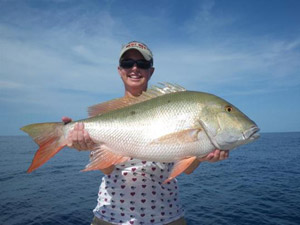 Mutton Snapper – Lutjanus analis
Mutton Snapper – Lutjanus analis
Florida Record 30lbs. 4 oz.
Mutton Snapper cast a strange spell over fishermen. Few fish have the mystic of spawning Mutton to the light tackle angler. On the full moon in mid summer, Mutton gather to spawn on the shallow reefs and this drives anglers into a frenzy! Powerful fish that are arguably the best eating fish in saltwater. What’s not to like about Mutton Snapper?
A little about them:
Mutton Snapper are members of the Lutjanidae family and inhabit much of the Atlantic coastline while encompassing all of the Bahamas as well. The common opinion of knowledgeable anglers is that the Florida Keys and especially Key West are certainly home to some of the largest specimens and definitely the largest population of these incredible fish.
Muttons are common to about fifteen pounds however, the current world record was taken in Key West and came in at 30 lbs and 4 ounces. Considered by most to be the hardest fighting of all the Snapper family, Muttons are excellent when targeted on light tackle. Typically not schooling fish, more usually found as one to less than five fish together the larger specimens are solitary fish except during the spawn each May, June, July and often times into August.
Feeding patterns and unique characteristics:
Muttons are found inshore in estuaries with grass beds, mangroves and at times in canals with coralline bottoms. Mutton Snapper when found shallow typically have the most brilliant colorations over fish taken from deeper depths. The larger fish will be most often being located offshore on deeper areas of the reef and can be mistaken for Red Snapper. Mutton actively feed during both daylight and nighttime hours moving from the deeper depth of 50 to 120 feet during mid-day to much shallower in low light conditions. Mutton are beautifully colored fish with an olive green coloration on their back and upper sides, a brilliant bright blue “line” runs just below the eye, and the fins below the lateral lines carry a reddish tinge. Notice the black “spot” just below the dorsal fin.
What you and your guide are looking for:
As bottom feeders, Muttons are surprisingly choosy about forage foods and bait. There is a divide between experienced Mutton anglers about the issue of the most productive bait choices. One school will preach that fresh “dead” baits such as Shrimp, Squid, Crabs and Speedo Mackerel are best while the other will only fish live Shrimp or Pinfish etc. Muttons can be caught on artificial also. At Key West Pro Guides, we have found both to be productive, as you would imagine. It becomes a personal preference at this point.
However, all agree Muttons are super sensitive to the presentation of bait. If anything does not seem 100% natural in appearance, it is going to be a long day. For example, never “jig” your bait off the bottom. Most agree night fishing for Muttons is best but the one thing all Mutton specialists agree upon is “patience is key” to catching Mutton Snapper.
Capt. Paul Tryon, Capt. Roc Mcguffey and myfwc.com were excellent sources for this material.
Nassau Grouper
 Nassau Grouper – Epinephelus striatus
Nassau Grouper – Epinephelus striatus
Florida Record 9lbs.
Nassau Grouper is a lesser known but fully appreciated Grouper to the angler. Fortunately, one of those few fish that feed better during the day Nassau make the perfect species to target during the typical mid-day action. For the hard-core reef fishermen the winter spawning period of the Nassau provides exception angling for quality sized fish.
A little about them:
The Nassau grouper is one of the large number of fish in the family Serranidae that are commonly referred to as groupers.
The Nassau grouper is a medium to large fish, growing to over a 3.5 feet in length and up to 55 pounds in weight. It has a thick body and large mouth, which it uses to “inhale” prey. Its color varies depending on an individual fish’s circumstances and environment. In shallow water (up to 60 feet), the grouper is a tawny color, but specimens living in deeper waters are pinkish or red, or sometimes orange-red color. Superimposed on this base color are a number of lighter stripes, darker spots, bars and patterns, including black spots below and behind the eye, and a forked stripe on the top of head
Feeding patterns and unique characteristics:
The Nassau grouper lives on the reef, it is one of the largest fish to be found around coral reefs. It can be found from the shoreline to nearly 330 feet deep water. The Nassau grouper lives in the western Atlantic Ocean, from Bermuda to Florida and the Bahamas.
It is a solitary fish, feeding in the daytime, mainly on other fish and small crustaceans such as crabs and small lobsters. It spawns in December and January, always around the time of the full moon, and always in the same locations. By the light of the full moon, huge numbers of the grouper cluster together to mate in mass spawning.
Capt. Paul Tryon, Capt. Roc Mcguffey and myfwc.com were excellent sources for this material.
Permit
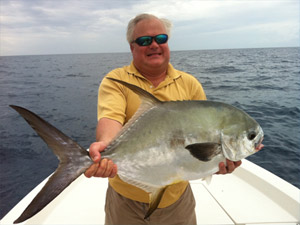 Permit – Trachinotus falcatus
Permit – Trachinotus falcatus
Florida Record 56lb. 2oz.
A little about them:
Permit are without a doubt the crown jewel of the wrecks and shallows. They have incredible eyesight, making approaching them a real task. Once hooked up they are the most tenacious of any fish their size. Their long, hard, runs are exhausting, even to the expert angler. In the Spring they school in large groups on the wrecks and reefs, making hooking them up rather easy. They are a close second to being the most sought after species in the springtime.
Feeding patterns and unique characteristics:
Permit, with out a doubt, have long been considered the ‘crown jewel’ of all of our flats species. They are by far the most finicky of feeders, the most tenacious of fighters and have a sense of smell that rivals most other fish. Permit prefer the deeper channels when not feeding, then venture onto the flats to forage on crabs, small clams and shrimp. Any well presented small crab will for sure get a look-see, this is the only vice they seem to have. The Permit have been gifted with exceptional eye-sight, more times that not, they will charge your bait, perform their circle dance around it and at the last second refuse it only to leave you holding the rod in utter shock.
What you and your guide are looking for:
When stalking your permit, there are a few things you and your guide want to look for.
“Fins & Tails” – When the Permit are in the skinny water feeding, they orientate their body so that their head can root through the grass, rousing up crabs and small shrimp. When they do this sometimes their tails and dorsal fin sticks through the water, like little black sticks. They usually do not move around to much, only a few inches at a time, this would be considered the ultimate opportunity to present your crab. If you can see which way they are orientated, place it three or four feet in front of them and let it drop to the bottom, if they don’t notice it right away, a few twitches should catch their attention.
“Cruisers” – When Permit are cruising the flats, they are looking for food, but are on the highest alert for predators. If you present the bait right on their heads, they will run from the attacking crab at warp speed, actually a sight that is pretty neat to watch. If you present the crab several feet in front of them and allow it to settle to the bottom, there is an excellent chance of a take. If for some reason they do not see the delicacy that has been offered, move it a little and hold your breath, if still no take, move the crab very lowly until he notices what its trying to get away.
Capt. Paul Tryon, Capt. Roc Mcguffey and myfwc.com were excellent sources for this material.
Pompano
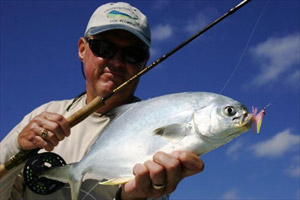 Pompano – Trachinotus carolinus
Pompano – Trachinotus carolinus
Florida Record 8lbs. 4 oz.
Pompano have been a well kept secret by a very few guides in Key West for many years. Most anglers have never seen much less landed one. These schooling fish can bring an excitement to any trip on the water. Hard fighters on light tackle, Pompano are perfect targets for the family outing looking for fast paced action in the shallows or the serious angler looking for table fare. Few guides understand the Pompano and its habits better than the pro’s at Key West Pro Guides. Be certain to add the Pompano to your “must catch” list, next visit to the backcountry.
A little about them:
The Florida Pompano are members of the Carangidae or Jack family. It has a compressed body with a deeply forked tail and short face. The Pompano’s coloration varies from blue-greenish silver on the dorsal areas and silver to yellow on the body and fins very similar to its cousin the Permit.
Feeding patterns and unique characteristics:
Pompano can be found along the western coast of the Florida Keys depending on the season, and is popular for both sport and commercial fishing. Most Florida pompano caught weigh approximately 3 pounds and are typically about than 18 inches in length. Florida Pompano reach about 12″ in length the first year. It is believed that Florida Pompano live approximately 3 to 4 years although fish as old as 7 years of age have been collected. Although there are recorded catches of Pompano weighing 8-9 pounds and reaching lengths of up to 26 inches. Because it is fast growing and desirable as table fare, the pompano is one of the more prized species found in the Key West backcountry. There are several sub-species of Pompano including African, Cayenne, Florida and believe it or not an Irish! The Florida Pompano is typically found in warmer waters from 70 to 89 degrees. The Pompano is a very fast swimmer traveling in schools so perfect to hook on light tackle. Small clams are its preferred forage food.
What you and your guide are looking for:
The Florida Pompano prefer the deeper holes and ledges of the backcountry. Some of the deeper holes, in the 15 to 20ft. area can hold schools in the hundreds. They small jigs tipped with prefer live shrimp. A slow retrieve through the grass areas works very well and do the larger sand depressions out to the west.
Capt. Paul Tryon, Capt. Roc Mcguffey and myfwc.com were excellent sources for this material.
Rainbow Runner
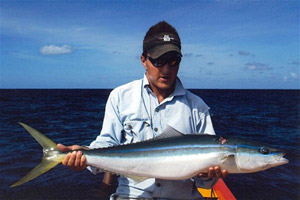 Rainbow Runner – Elagatis bipinnulata
Rainbow Runner – Elagatis bipinnulata
Florida Record 23lbs.
A little about them:
The Rainbow Runner is always a welcome visitor when on the reef fishing for other species. They are fast swimmers that make for great fun, especially on light tackle. They can be finicky eaters, sometimes only feeding on the chum meant for other fish.
Feeding patterns and unique characteristics:
Rainbow Runners frequent the many reefs and shallow wrecks in both the Atlantic and Gulf of Mexico. They hold in large schools and once located make for a productive time on the water. The color of the fish is possibly the easiest way to identify the rainbow runner, with the name taken from the species striking colors. The upper body is a dark olive blue to green and fading to white underneath.
What you and your guide are looking for:
Rainbow Runners are usually caught when fishing for another species like Yellowtail snapper. They are drawn in by the chum slick and have no fear of coming close to the boat for a free meal. Their mouths are quite small, only the lightest leader and smallest hooks catch them. Definitely save a few for dinner, the meat is excellent table fare.
Capt. Paul Tryon, Capt. Roc Mcguffey and myfwc.com were excellent sources for this material.
Redfish
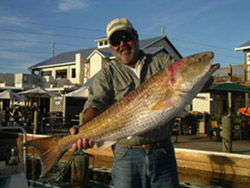 Redfish – Sciaenops ocellatus
Redfish – Sciaenops ocellatus
Florida Record 52lb. 5oz.
Red Drum or Redfish (Sciaenops ocellatus) is also known simply as “Reds” is a popular game fish found from Massachusetts to south Florida in the Atlantic Ocean and Gulf of Mexico. The Red Drum is a cousin to the Black Drum and the two species are often times found in close proximity to one another. They do interbreed which forms a hybrid.
A little about them:
Red Drum or Redfish typically are red in color on the back but fades into a white belly. Characteristic false eyes near the tail sometimes in multiples are commonly found on their streamline body shape. Fish having no “eye” spots are very rare however. It is thought that as a fish with multiple spots grows older the spots are lost. Many fish have similar markings to aid in escape from predators. Reds grow quickly and can easily achieve eight pounds within three years. Typically anglers refer to the largest Reds as “Bulls” at about 27 inches in length overall. Red Drums have been recorded in excess of 94 pounds.
Feeding patterns and unique characteristics:
Reds have a conical shape or down-turned mouth, which indicates a bottom feeder. Reds feed by “vacuuming” the bottom. Reds have a sensitive touch and see very well in off colored waters. Reds feed on several forage foods but have seasonally preferences. During the summer and fall period Crabs and Shrimp are number one however during other timeframes Menhaden, Mullet, Pinfish, among many baitfish all produce. Red drum are plentiful along the southern Atlantic and into the Gulf of Mexico coasts of Louisiana, Texas, Alabama and Mississippi as well as Florida. Younger red drum prefer grass marsh areas of bays and estuaries but Reds of all sizes prefer rocky outcroppings such as jetties or manmade structures. Reds spawn in shallow and near shore waters from August to mid October. Females’ lay about 1.5 million eggs and these eggs hatch within 24 hours under normal conditions. Reds can reproduce from about 4 years of age. Reds have an unusually long life span of approximately 60 years.During the 80’s Chef Paul Prudhomme created “blackened Redfish” a Cajun style dish and the popularity of reds as table fare exploded. Red Drum has a moderate flavor and is not oily. A rule of thumb…the larger the fish the more difficult to clean. Filleting is recommended for adult Redfish targeted for the table. Most agree younger Reds are the best tasting.
What you and your guide are looking for:
Redfish can be found on the shallow reefs and in the backcountry in the channels and on the flats. They are a schooling fish, making catching them easy once you locate the school. Sometimes you see them ‘tailing’ on the flats or in the basins they mud like Mullet. On the shallow reefs, you actually see the color of the water change ot a dark tan when the schools are present!
Capt. Paul Tryon, Capt. Roc Mcguffey and myfwc.com were excellent sources for this material.
Red Grouper
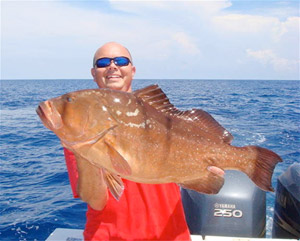 Red Grouper – Epinephelus morio
Red Grouper – Epinephelus morio
Florida Record 42lb. 4oz.
A little about them:
The red grouper is a species of fish in the Serranidae family. Its natural habitats are open waters, shallow seas, sub-tidal aquatic beds, coral reefs, rocky shores, sandy shores, estuarine waters, inter-tidal flats, inter-tidal marshes, coastal saline lagoons, and coastal freshwater lagoons.
Feeding patterns and unique characteristics:
The Red Grouper is an opportunistic feeder and a top predator in the reef community. The diet is varied but commonly includes small fish, crabs, spiny lobster, and snapping shrimp. The Red grouper is of moderate size, about 4 feet in length and weighs 50 pounds or more. Body coloration is typically reddish-brown color. White spots are commonly found on the body of the red grouper.
What you and your guide are looking for:
Red Grouper can be found on most any shallow reef or wreck to about 120ft. they are numerous on the ‘patch reefs’ usually holding to the perimeter with the Blacks and Gags. They love Squid, live Pinfish and jigs tipped with Bonita strips. Basically any structure to about 120ft. will hold large schools of them.
Capt. Paul Tryon, Capt. Roc Mcguffey and myfwc.com were excellent sources for this material.
Red Snapper
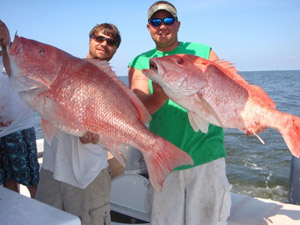 Red Snapper – Lutjanus campechanus
Red Snapper – Lutjanus campechanus
Florida Record 46lbs. 8oz.
The Red Snapper is a fish found in the Gulf of Mexico and the southeastern Atlantic coast of the United States and, much less commonly, northward as far as Massachusetts.
A little about them:
The Red Snapper commonly inhabits waters 30 to 200 feet deep, but some are reported to be caught at 300 feet deep. All feature a sloped profile, medium-to-large scales, a spiny dorsal fin and a laterally compressed body. The maximum published age of a caught red snapper was reported to be 57 years.
Feeding patterns and unique characteristics:
Coloration of the Red Snapper is light red, with more intense pigment on the back. A Red Snapper attains sexual maturity at two to five years old. An adult snapper can live for more than 50 years and weigh 50 pounds. Red snapper are a prized table fare species.
The preferred habitat of Red Snapper changes as it grows and matures due to increased need for cover and changing food habits. Newly hatched Red Snapper spread out over large areas of open benthic habitat, then move to low-relief habitats, such as oyster beds. As they near one year of age, they move to intermediate-relief habitats as the previous year’s fish move on to high relief reefs with room for more individuals. Around artificial reefs such as oil platforms, smaller fish spend time in the upper part of the water column while more mature (and larger) adults live in deeper areas. These larger fish do not allow smaller individuals to share this territory. The largest Red Snapper spread out over open habitats, as well as reefs.
What you and your guide are looking for:
Red Snapper here in Key West are caught deep. Usually deeper than 240ft. they prefer the cooler water temps. Some of the wrecks way to the west, hold large schools of them. Basically any small live bait is a good choice. You need stout tackle for water that deep and fish of more than 20lbs.
Capt. Paul Tryon, Capt. Roc Mcguffey and myfwc.com were excellent sources for this material.
Sailfish
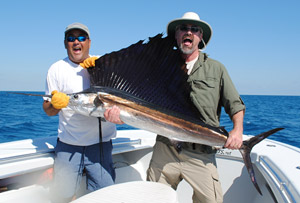 Sailfish – Istiophorus albicans
Sailfish – Istiophorus albicans
Florida Record 126lbs.
When you mention Sailfish, anglers quickly picture the iconic sport fish “tail walking” across the surface. A top rated and prized species of billfish, in Key West we are blessed with a huge migratory population from January through the end of May.
Although there are actually two different species of Sailfish in the warmer waters around the world, ours in Key West are the Atlantic Sailfish with the other specie being the Indo-Pacific.
A little about them:
Istiophorus albicans is the family of the Atlantic Sailfish, which are easily recognized from all other species of billfish. They are predominantly blue to grey in color and have a large dorsal fin known as the sail. This fin often times reaches the entire length of the back while Sailfish also have an elongated bill resembling the Marlin, Swordfish and other specimens of the broadbill family. Sailfish appear in a startling array of colors from a dull brown to vibrant purple with black and silver dots. Iridescence stripes appear commonly. Sailfish change colors almost instantly controlled by their nervous system. I have witnessed Sailfish in light blue hues and yellow strips are not impossible either. It is believed the rapid changing of colors by the sailfish may be a communication of sorts to other sailfish or to possibly confuse schools of forage fish.
Feeding patterns and unique characteristics:
Sails do grow quickly reaching 4′ to 5′ in their first year but rarely reach 10’in length or 200 pounds. Sails feed on the surface to the mid depth levels on squid and smaller pelagic fish. Sailfish are true speed demons and have been reliably clocked at 68 miles per hour, making them the fastest fish in the ocean.
The magnificent sail is typically folded down and to the side of the fish unless excited or frightened. Displayed to make the fish appear to be larger than it actually is as defense, the sail is also used during feeding when herding forage fish.
What you and your guide are looking for:
Sailfish prefer the reef edges and offshore near color changes and back eddies. All three locations have one thing in common, they hold bait. In the wintertime when the Ballyhoo school on the reefs, you’ll see the Sails showing the bait, driving it into only a few feet of water. They use the color changes as a curtain, they run back and forth from the clear gulfstream waters through the dirtier bay water and ambush the baits that hold their. The back eddies trap bait between the currents; the sailfish ball them up and slash through them, picking off the injured baitfish. Free lining live baits while drifting is a great way to target them, so is a troll through either of these three scenarios.
Capt. Paul Tryon, Capt. Roc Mcguffey and myfwc.com were excellent sources for this material.
Sea trout
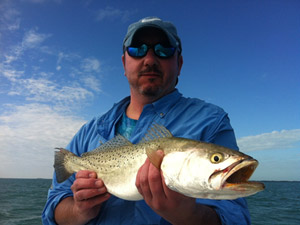 Sea trout – Cynoscion nebulosus
Sea trout – Cynoscion nebulosus
Florida Record 17lbs. 7 oz.
Sea Trout…it’s a good thing they don’t grow much larger or it would be dangerous to be around them. Sea Trout are veracious feeders and not the least bit picky about what they eat. Super ambush predators, Sea Trout could teach snipers a thing or two. Aggressive is an understatement for Sea Trout. On those rare foul weather days in the keys you can always count on Sea Trout. Easy techniques and simply presentations put Sea Trout at the top of the list for fun fishing!
A little about them:
Contrary to its name, the spotted sea trout is not a member of the trout family but rather of the drum family like Redfish. Adult Sea Trout reach 18-25 inches in length and 1-6 pounds in weight. Particularly larger Sea Trout are referred to as “Gator Trout”. Sea Trout are schooling fish that provide excellent action and a perfect fish to target with younger or novice anglers. It takes between one and two years for sea trout to reach 12 inches and between two and three years to reach about 16 inches. The average size of spotted sea trout in Key West is from 1-2 pounds but fish up to 5 lb are fairly common. Fish weighing 8-10 pounds are rare.
Feeding patterns and unique characteristics:
Small trout eat large amounts of shrimp and other crustaceans. As they grow larger, their diets shift toward fish, the larger, the better. Studies indicate that really big trout strongly prefer to feed on Mullet which are plentiful in Key West. A large trout will find the largest mullet it can handle and try to swallow it. Often the mullet is half or two-thirds as large as the trout. Now that’s an aggressive feeder, no wonder they just crush our baits! Often fished with the aid of floats and “popping corks” in the grassy bays with live shrimp as a first choice bait by most experienced guides in Key West. Careful…the spotted sea trout has prominent canine teeth. Sea Trout have an elongated, soft dorsal fin with no scales and it is separated from the dorsal fin by a deep notch. It usually has two anal spines and the lateral line extends to the tip of the caudal fin. The back has distinct spots scattered on it, including on the dorsal and caudal fins.
What you and your guide are looking for:
Sea trout prefer waters very similar to that of the Lady Fish. If in a Basin, looking for the deeper grass bottoms where large schools of bait hide should pay off well. You will find them on the peripheral of the Mullet muds and bottom with both broken ledges and grass. Sea trout also prefer channels with a mud bottom, again looking for the deeper depressions and ambush points.
Capt. Paul Tryon, Capt. Roc Mcguffey and myfwc.com were excellent sources for this material.
Skipjack Tuna
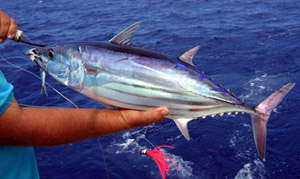 Skipjack Tuna – Euthynnus pelamis
Skipjack Tuna – Euthynnus pelamis
Florida Record 33lbs. 8oz.
A little about them:
Skipjack Tuna is a medium-sized fish in the tuna family. It is otherwise known as the aku, arctic bonita, oceanic bonita, striped tuna, or victor fish. Always enjoyable on light tackle gear typically taken while trolling for offshore pelagic species in Key West.
Feeding patterns and unique characteristics:
It is a streamlined, fast-swimming pelagic fish, common in tropical waters throughout the world, where it inhabits surface waters. It is an important prey species for large pelagic fishes and sharks.
It has no scales, except on the lateral line and the corselet (a band of large, thick scales forming a circle around the body behind the head). It commonly reaches fork lengths up to 31 inches and a weight of 18-22 lb. Its maximum fork length is 43 inches and maximum weight is 76 lbs. Ageing skipjack tuna is difficult, and the estimates of its potential lifespan range between 8 and 12 years.
Skipjack tuna is a batch spawner. Spawning occurs year-round in equatorial waters, but it gets more and more seasonal further away from the equator. Fork length at first spawning is about 18 inches.
What you and your guide are looking for:
Skipjack are generally taken while trolling for Dolphin, Sailfish and Tuna. Offshore you can sometimes see the birds working on the baitfish the Skipjacks are feeding on. Many times you’ll also see them jumping in the water while chasing bait. They are awesome fighters and make for a great meal, some hold them higher than Blackfin for taste.
Capt. Paul Tryon, Capt. Roc Mcguffey and myfwc.com were excellent sources for this material.
Snook
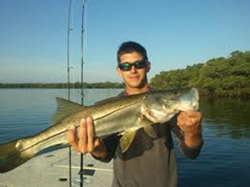 Common Snook – Centropomus undecimalis
Common Snook – Centropomus undecimalis
Florida Record 44lb. 3oz.
A little about them:
The common Snook is also known as the sergeant fish or Robalo. Common Snook are protandric hermaphrodites, changing from male to female after maturation. This transition is identified by the presence of both male and female sex cells in the gonads and takes place when they grow to between 10 & 24 inches fork length, which corresponds to 1-7 years of age. The majority of small common Snook are male and most large Snook are female. Males reach sexual maturity during their first year at approximately 8 inches fork length.
Feeding patterns and unique characteristics:
One of the largest Snook, the common Snook grows to a maximum overall length of 4.6 ft and a maximum-recorded weight of 53 lb. Snook possess a drab coloration except for a distinctive black lateral line. It can also possess bright yellow pelvic and caudal fins, especially during spawn. Snook are aggressive strikers and are often times very difficult to fool with even the best presented bait.
What you and your guide are looking for:
Although occurring in shallow coastal waters as deep as 65 ft depth, most Snook are found shallow mangrove lagoons and near structure in clean water. Here in Key west we occasionally catch them in the Gulf on the smaller, less frequented wrecks and along other shallow structures. The Marquesas has a rather large population of big Snook, mainly because of the freshwater influences during the summer rainfalls and the lack of boat traffic, making them comfortable in the channels near the mangroves. Snook are carnivorous, with a diet dominated by smaller fishes, and crustaceans such as shrimps, and occasionally crabs.
Capt. Paul Tryon, Capt. Roc Mcguffey and myfwc.com were excellent sources for this material.
Spanish Mackerel
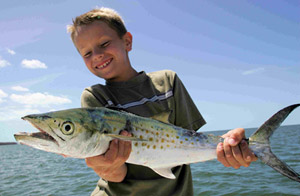 Spanish Mackerel – Scomberomorus maculatus
Spanish Mackerel – Scomberomorus maculatus
Florida Record 12lb.
A little about them:
The Spanish mackerel is a migratory species of fish that swims to the northern Gulf of Mexico in spring, returns to south Florida especially in the waters of Key West and in the eastern gulf, and to Mexico in the western gulf in the fall. Spanish Mackerel are schooling fish that provide excellent action for light tackle anglers. Close to its first cousin, the King Mackerel and sharing many of the same attributes appreciate by the angler. Extremely speedy, lightning bolt strikes and plentiful…what more could you ask for in a sport fish!
Feeding patterns and unique characteristics:
The Spanish mackerel exhibits a green back; its sides are silvery marked with about three rows of round to elliptical yellow spots. Its lateral line gradually curving down from the upper end of the gill cover toward caudal peduncle. The first (spiny) dorsal fin is black at the front. Posterior membranes are white with a black edge. Its single row of cutting edged teeth in each jaw (around sixty-four teeth in all) are large, uniform, closely spaced and flattened from side to side. These teeth look very similar to those of the King Mackerel and the Cero Mackerel.
What you and your guide are looking for:
Spanish mackerel are voracious, opportunistic carnivores. As with other members of the Mackerel family, food consists mainly of small fishes with lesser quantities of shrimp and squid. Spanish mackerel are found on the patch reefs in both the Atlantic and Gulf. Looking for large flocks of birds is a sure sign of mackerel activity nearby. You also find schools of Spanish mackerel in the lower Keys basins and channels. They prefer top water plugs and flashy spoons. Fast erratic movement works best as they are reactive strikers.
Capt. Paul Tryon, Capt. Roc Mcguffey and myfwc.com were excellent sources for this material.
Stingrays
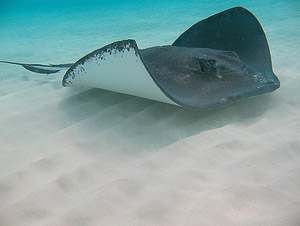 Stingray – Dasyatis sabina
Stingray – Dasyatis sabina
No Florida Record
Sting Rays are as much a part of the Florida keys as are Palm trees. Rays are so numerous you just don’t see them until you are in the backcountry. In these shallow, crystal clear waters Sting Rays take on an almost hypnotic state. Quietly resting on the sandy bottom only to swoosh away as we approach them. Busily feeding in mere inches of water Sting Rays provide a glimpse into our wondrous marine life of Key West.
A little about them:
Stingrays are a group of fishes known as “rays”. Rays are cartilaginous fishes related to sharks. There are at least eight different subspecies of rays around the world such as Eagle rays common to Key West at certain times of the year. Others are Six gill rays, Round rays, Butterfly rays, Whiptails, River Stingrays, Deep Water rays and Stingrays. Not all rays have the venomous barbed tails we all associate Stingrays with, The Manta Ray as well as the Porcupine Ray do not carry this self-defense weapon. Some of those rays armed with these tails can grow them to a length of 14 inches.
Rays are common in most tropical and subtropical coastal waters around the world. There are freshwater rays as well found in many rivers. Only some salt-water rays are pelagic but all fresh water rays are restricted. For the most part the wide spread Stingray is not threatened however the conservation status of some in the ray family are listed as vulnerable or endangered with many species of rays being listed as data deficient since so little is known about them.
Feeding patterns and unique characteristics:
The flattened bodies of Stingrays allow them to effectively hide themselves on the bottom by agitating the sand. With eyes atop the head and mouths below, rays cannot see their prey so must rely on a keen sense of smell or electroreceptor’s as do sharks. Stingrays feed primarily on mollusks and crustaceans but will also devour small fish. Some Stingrays mouths contain strong muscles for crushing while others only have sucking mouths. Coral reef areas are commonplace feeding grounds for rays, as they lie on the bottom with only their eyes and tail visible.
Rays are ovoviviparous bearing lie young in litters of five to thirteen offspring. Stingrays it is thought have the ability to store sperm and deliver babies when the time is right. Stingrays are usually very docile and curious, typically fleeing from any disturbance. Stingrays commonly will “brush” their wings against any curious thing they come in contact with. There are several locations around the Caribbean where diving and snorkeling are allowed, as is the feeding of stingrays. Keep in mind, in these locations the stingrays are very use to people and do not present any real risks. Places such as Stingray City on Grand Cayman or the area neat Antigua in a shallow reserve where the rays are accustom to human contact.
Stingrays contrary to belief do not aggressively attack humans though stings do occur when wading people step on them in the surf or shallows. This is why it is said to “shuffle” your feet when wading near the beach. Another method of precaution against accidental stings is to pitch stones in the water before entering to scare the rays away. Contact from the stinger will cause local trauma from the cut itself with pain, swelling, muscle cramps as a result of the venom. You may also experience an infection from the bacteria as well. Although a painful injury, it is seldom life threatening unless the stinger pierces a vital area of your body. The barb typically breaks off in the wound and could require surgery to be removed.
Some may find it interesting that rays are edible. Caught as food by use of both lines and spears, Stingrays are consumed around the world. Recipes abound with the using of the dried “wings” of the ray usually. Rays are commonly grilled and served with a sambal sauce from Singapore to Malaysia. The wings or more properly the “flaps” are sought after as is the “cheek” areas about the eyes and the liver as the rest of the ray is thought to be too “rubbery” for any further culinary uses.
The skin of the ray is still commonly used in the making of wallets, belts and jackets, cell phone cases and even Japanese sword sheaths. The stingrays hide texture is strong and very durable.
Key West is home to a massive population of Stingrays and to view them in the wild is a daily occurrence. If you would like to know more about seeing Stingrays in Key West call the Key West Pro Guides team and set up a fishing charter for the flats or backcountry and while catching fish you will most certainly see many stingrays in the pristine clear waters around the island. 866 259.4205 we look forward to your call!
Capt. Paul Tryon, Capt. Roc Mcguffey and myfwc.com were excellent sources for this material.
Swordfish
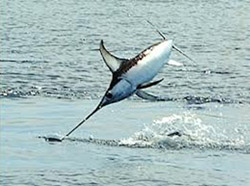 Swordfish – Xiphias gladius
Swordfish – Xiphias gladius
Florida Record 612lbs. 12 oz.
Swordfish fishing has absolutely exploded over the past few years. Until recently, very few guides had any real experience or success catching Swordfish. For some time targeting Swordfish meant fishing through the nighttime hours well offshore near the commercial shipping lanes. Success rates were poor and frustrating most times. Today armed with a tremendous amount of “new knowledge” about these impressive billfish we are moving forward with ever-increasing productivity for the angler. At best, Swordfish are not an easily found or landed species to target. These charters require long hours on the water, very specialized equipment and angler tenacity but the pay-off is awesome. Few guides can stand on the dock with the Key West Pro Guides team when Swordfish are the topic of conversation.
A little about them:
Swordfish also known as Broadbills (members of the Billfish category) are highly migratory, predatory fish with an elongated round body and long, flat bill. In recent years, the Swordfish has become a very popular sport fish although very elusive.
Swordfish are found in tropical and temperate waters of the Atlantic, Pacific and Indian Oceans. Swordfish can be found at the surface basking or as deep as 1800 feet deep normally and have been recorded to reach 9400 feet. Large fish that routinely reach nearly 10 feet in length, however behemoths have been reported to 14 feet plus and tipped the scales at 1,400 pounds. The International Game Fish Association records the all time rod and reel Swordfish as taken off Chile in 1953 and came across the scales at 1,182 pounds.
Feeding patterns and unique characteristics:
Swordfish are believed to live about 9 years with the Pacific Swordfish growing largest. Females are the larger between the sexes maturing about 4 to 5 years of age. In the Caribbean, it appears Swordfish spawn year round and the largest females may carry as many as 29 million eggs. Surprisingly Swordfish lose all their teeth by adulthood.
Swordfish are known as ectothermic animals, which are those that cannot regulate their own body heat such as reptiles that must bask in the sun to warm themselves. Interestingly it has been found that Swordfish like some deeper swimming sharks, Marlin and some Tuna do have a special organ located near the eyes to warm them and their brain.
Many anglers make the mistake of thinking the bill is used as a spear to stab prey however, it more likely uses its bill to slash. Swordfish mainly rely on speed to catch prey and is clearly one of our fastest swimming fish although reports of 60 MPH are unreliable.
Except for humans, adult Swordfish have few enemies. I have read about Mako sharks and Killer Whales as predators towards the Swordfish. Although there are, no known reports of attacks on humans Swordfish are dangerous nonetheless. There are the occasional tales of Swordfish when hooked diving so quickly as to ram the shallow ocean floor and of running their swords through small plank built boats if injured.
As table fare, the FDA due to possible mercury levels in the flesh does not recommend Swordfish for small children or pregnant women. Some Swordfish are referred to as “pumpkin swordfish” due to the color of their rosy colored meat thought to come from a diet of mainly shrimp. Swordfish is popular and sold often as steaks for grilling as the meat is relatively firm.
What you and your guide are looking for:
Swordfish are finicky fish with limited tolerances for its environment. Preferring water temperatures between 64 degrees and 74 degrees, most Billfish range from about 40 to 80 degrees. Swordfish feed daily, typically at night, at times on or near the surface preferring smaller pelagic species such as mackerel and herring although will feed on squid and crustaceans as well.
Capt. Paul Tryon, Capt. Roc Mcguffey and myfwc.com were excellent sources for this material.
Tarpon
 Tarpon – Megalops atlanticus
Tarpon – Megalops atlanticus
Florida Record 243lb
A little about them:
Tarpon are the true brutes of the shallows. They can grow in excess of 300lbs. and at only 150, put up a fight for more than 2 ½ hours. Their acrobatic leaps and blistering runs make them a handful on the heaviest of tackle. They enter the Lower Keys in February to head offshore to spawn, leaving our waters in late July. They are the absolute most sought after species in the springtime.
Feeding patterns and unique characteristics:
The Florida Keys are world renowned for our incredible population of “The Silver King”. Key West has long been known as the premier destination for serious Tarpon anglers looking to sight cast to these brutes in our gin clear waters, all without another boat in sight! The Tarpon are by far the largest of our flats fish, mid-sized ones from around 30 to 75lbs., large sizes running 80 to 120lbs. and monsters more than 125lbs. The Tarpon run usually starts the latter part of January, peaks in May and begins to taper off around the beginning of July. The Tarpon are aggressive feeders that readily take well presented large streamer flies, live baits like Mullet and Pinfish and love top water plugs.
What you and your guide are looking for:
Tarpon are some of the hardest fish to spot. When the conditions are good, you can sometimes see them rolling on the surface. Rolling Tarpon on the surface can show several signs; silver sides, black backs or their tails flipping as they go under. Wearing a good quality pair of polarized sunglasses will help you see the fish that your guide points out. When casting to rolling Tarpon, either lead them a little or put it in the heart of the school. When throwing flies, try to lead them by about 3 to 5 feet, this allows the fly to sink just a little, strip it slowly with short strips. When throwing plugs, lead them just a little, say 3 to 5 feet and keep your retrieve slow and steady, Tarpon are opportunistic feeders, don’t make them work for it, tease them and make it easy. When they hit, Fly or Plug, multiple hook sets are key. They have very hard; bone like mouths, the sharper the hook, the better. Bang-Bang-Bang!
Tarpon Facts:
- The life span of a tarpon can be in excess of 50 years. The oldest tarpon in captivity lived to be 63 years old.
- Fossil research shows that tarpon have been swimming in our oceans since prehistoric times.
- Tarpon is the only fish with an air bladder which allows it to absorb oxygen and live in waters with almost no oxygen content.
- Tarpon above 90 lbs. are almost certainly females.
Capt. Paul Tryon, Capt. Roc Mcguffey and myfwc.com were excellent sources for this material.
Tripletail
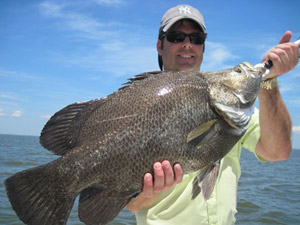 Tripletail – Lobotes surinamensis
Tripletail – Lobotes surinamensis
Florida Record 40lbs. 13oz.
A little about them:
The Tripletail is a warm-water marine fish found across the tropics and can grow to 3 feet in length and weigh 40 pounds it is also known by anglers by names like flasher or steamboat. Young Tripletails float on their sides, often beside flotsam, and appear like a dry leaf.
Feeding patterns and unique characteristics:
Atlantic tripletails are found coastally in most, but not all, tropical and subtropical seas. They are normally solitary however; they have been known to form schools. They can be found in bays, sounds, and estuaries during the summer. Juveniles are usually found swimming under patches of Sargasso algae. In the Gulf of Mexico, adults are usually found in open water, but can also be found in passes, inlets, and bays near river mouths. Young fishes are also often found in or near shipwrecks, beams or supports, jetties, flotsam and sea buoys.
Tripletails are easily overshadowed in fisheries such as Key West. In my opinion, Tripletail offers the angler so many wonderful attributes I am okay with keeping them away from the spotlight! Excellent as table fare, brutish strength when hooked on light tackle, these plentiful and easily found fish can provide the knowledgeable angler outstanding sight-casting action while in open water. Always glance to those channel buoys as you ride past. Well-positioned casts with a live shrimp usually produces a strike!
What you and your guide are looking for:
Atlantic tripletails are opportunistic eaters. This means that they feed on a variety of things, mostly small finfish. They also feed on crabs and shrimp, as well as other crustaceans. Offshore you find them near any flotsam or jetsam that has been in the water long enough to attract small baitfish or growth. If you’re lucky enough to find the classic bucket or barrel, pitch a bait to the opening, 9.9 out of 10 times a monster will sneak out to snatch up the meal. Large patches of seaweed tend to hold them too, anything that hold bait will hold tripletail.
Capt. Paul Tryon, Capt. Roc Mcguffey and myfwc.com were excellent sources for this material.
Wahoo
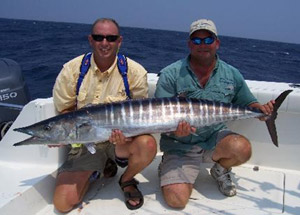 Wahoo – Acanthocybium solandri
Wahoo – Acanthocybium solandri
Florida Record 139lbs.
Wahoo! Which came first the fish or the exclamation…maybe at the same moment? Wahoo are magnificent predators. Fabled as fast swimmers that strike like lightning Wahoo are prized sport fish by most offshore anglers. Stunning fish Wahoo are elusive targets making them all the more cherished as trophy’s.
A little about them:
Wahoo are found worldwide in tropical and sub tropical oceans. A prized sport fish renowned for the incredible speed and strength they attain when attacking baits. Measured up to 50 mph the Wahoo is one of the fastest fish in the ocean. Long, line-stealing runs are typical from hooked Wahoo, spot lighting them as perfect light tackle targets on equal with Marlin or Yellow Fin Tuna with the heavy tackle sport fishermen. Those anglers in the know also appreciate the Wahoo as table fare, as their flesh is white and delicate. The Wahoo is known as “Ono” in Hawaii which loosely translates to “tasty” or “delicious”.
Feeding patterns and unique characteristics:
The Wahoo has an elongated body shape covered with nearly invisible scales. The vibrant coloring of the Wahoo is spectacular. The back is an iridescent blue with vertical blue stripes across the silvery sides. Wahoo are definitely apex predators growing beyond eight feet in length and in excess of one hundred and eighty pounds. Armed with keen eyesight, a huge mouth and razor like short, close set teeth the Wahoo prefers to forage on numerous baitfish and Squid. These pelagic assassins rely on surprise as the vault from below to ambush prey at the surface. Often confused by anglers with King Mackerel, the smaller Spanish or Cero Mackerel, which are all first cousins, or Barracuda the Wahoo is easily distinguishable by its large blade-like tail.
Wahoo by nature tend to be solitary fish. In Key West, we do often find them in smaller groups of one to less than five fish at times not far offshore. Wahoo known as “Peto” in the Hispanic areas of the Caribbean have been reported in schools numbering one hundred fish.
The Wahoo would be at the top of more anglers “favorite species list” if it were not for the fishes unpredictability. Most pelage’s are easily found in our local waters around Key West such as Mahi-Mahi under Frigate birds offshore or Sail fish in April when the strong north and east winds come, but not the Wahoo.
What you and your guide are looking for:
Until recently, most guides in Key West had not put together the patterns of Wahoo or developed the tactics to target them. For the most part Wahoo were appreciated “bonus fish” taken when trolling a deep line in the spread. We now realize that Wahoo are far more structure-oriented than first thought to be. Larger Wahoo can be found routinely along the shelf here in south Florida if the commitment to travel to the distant and remote fishing grounds is made. We now believe conditions such as the wind play a far less importance to Wahoo fishing. Whether 20 knots from the south or flat calm, the bite may not necessarily be affected.
We are aware that Wahoo can be taken not only from the Atlantic but also from wreck-sites well out into the Gulf. Wahoo have been reported in large schools seen motionless over the wrecks. We believe today that speed not depth may be key in catching Wahoo on heavy tackle. However, thankfully for the light tackle guides in Key West a local technique has proven to be just as productive. We are refining a slow and deep method as reported by the Florida Sportsman magazine recently. By shutting the engines off we wait for the Wahoo to come to us by presenting live baits such as the popular “Speedo” or any “Blue Runner”, Herring” etc. type bait on 20 or 30 pound class outfits staggering the baits at 100 foot intervals.
We are certain that first light/daybreak and sunset are prime Wahoo feeding timeframes and the afternoon tide change near the full moon should not be overlooked either. Although we all agree the best time to catch a Wahoo is when you least expect it.
Capt. Paul Tryon, Capt. Roc Mcguffey, Florida Sportsman and myfwc.com were excellent sources for this material.
Yellow Jack
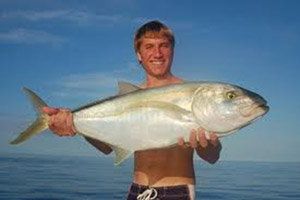 Yellow Jack – Carangoides bartholomaei
Yellow Jack – Carangoides bartholomaei
Florida Record n/a
A little about them:
The yellow jack is a species of jack found on the flats and over the many reefs and wrecks. It is one of only two representatives of its genus present in the Atlantic Ocean inhabiting waters off the east coast of the Americas from Massachusetts in the north to Brazil in the south, as well as a number of offshore islands from Bermuda throughout the West Indies and Bahamas. The species predominant common name, “yellow jack”, comes from the color the species turns, as it gets older.
Feeding patterns and unique characteristics:
Yellow jacks are predatory fish, moving both individually or in small groups. The Yellow jack primarily feeds on smaller fish, although observational records also show smaller benthic prey is taken.
Yellow jack have been observed in a ‘following role’, moving around with larger species to take advantage of the commotion caused by the bigger fish, allowing the jack to opportunistically forage on scraps left by the larger fish. Yellow jack have been recorded following eels, stingrays and nurse sharks, all common in Key West waters. Juveniles live near the surface of the ocean, often hiding amongst large mats of Sargasso weed, with a coloration that camouflages the fish in the weed. These young fish are often moved long distances by the Gulf Stream, and this is probably the process responsible for fish found as far north as Massachusetts.
What you and your guide are looking for:
Yellow jacks can be extremely finicky eaters and usually show up in your chum slick while fishing the reefs and wrecks. Having a small live bait is a great way to battle one of these brutes. They are very strong fighters and can easily spool a light outfit. They are absolutely delicious; especially when you consider that they are in the jack family. In the shallows when they are behind the rays and sharks, a top water plug is deadly, they can’t resist the urge.
Capt. Paul Tryon, Capt. Roc Mcguffey and myfwc.com were excellent sources for this material.
Yellow Tail Snapper
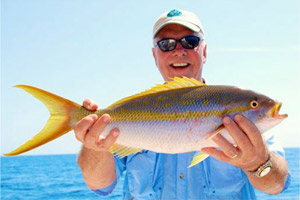 Yellowtail Snapper – Ocyurus chrysurus
Yellowtail Snapper – Ocyurus chrysurus
Florida Record 8lbs. 9 oz.
Yellow Tail Snapper are so plentiful in Key West that catching your limit in minutes is routine. Once you have the school of fish which can be substantial, behind the boat in your chum line the action heats right up. This is not to say Yellow Tail are found or caught easily, in fact, Yellow Tail are very cautious and wary adversaries for the light tackle angler. You must understand the techniques and idiosyncrasies of Yellow Tail fishing to have any success whatsoever. Fishing with a talented guide is a necessity. The pay-off is quite rewarding from fast paced action to enjoying delicious table fare.
A little about them:
The Yellow Tail Snapper is an abundant species of the Snapper family found along the North American coast line in the Atlantic from Florida south through the West Indies.
Yellow Tail are very commonly found on our reef and shipwrecks here in Key West from thirty to one hundred and twenty feet of water. Excellent as table fare Yellow Tail are consider by many to be the best of all Snappers on the plate.
Capt. Paul Tryon, Capt. Roc Mcguffey and myfwc.com were excellent sources for this material.









